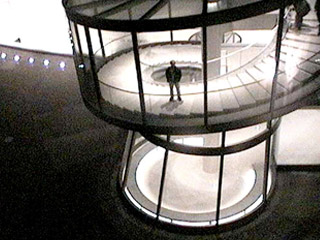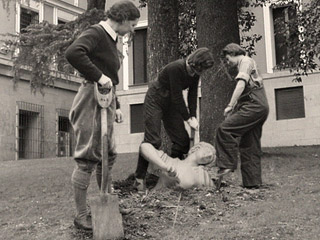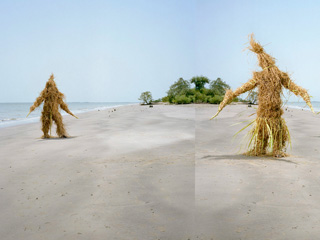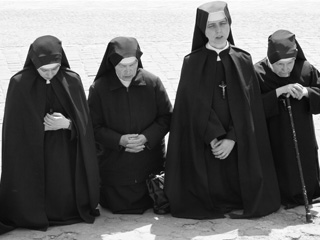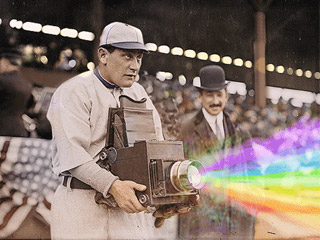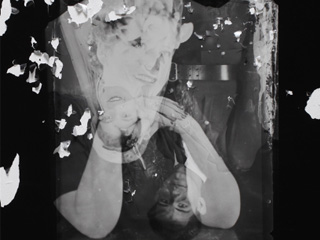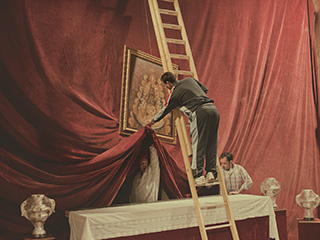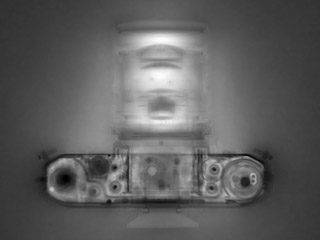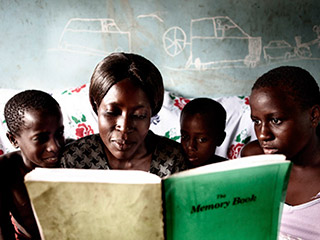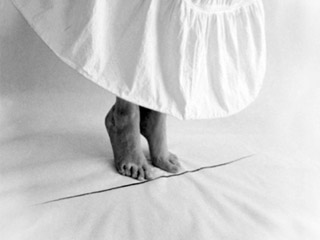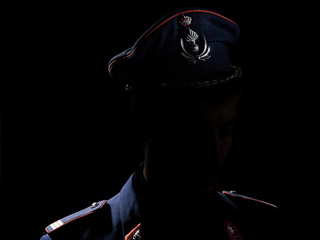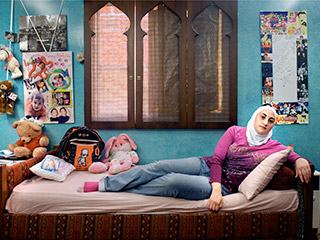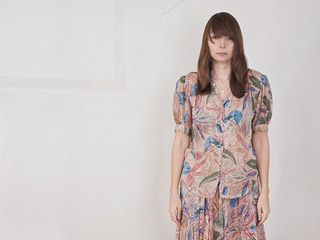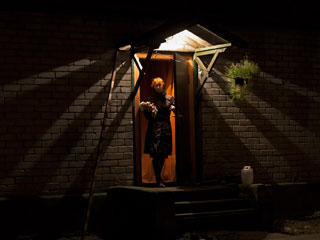Jens Sundheim
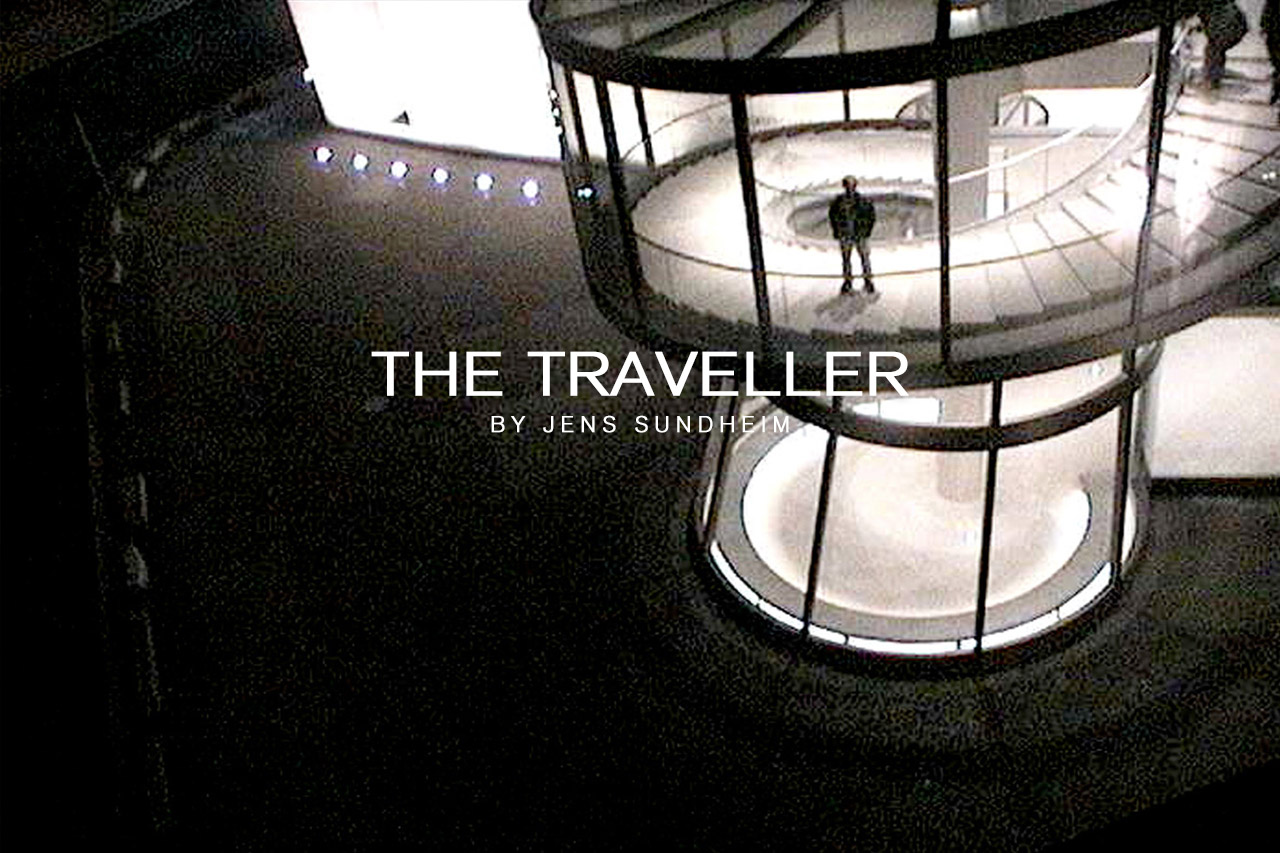
For 14 years now I have been following the traces of public webcams: cameras installed in public or private spheres that automatically record images and spread them via internet.
I research where they are located, travel there, and get myself photographed. I give these cameras a human face. New York and Moscow, Las Vegas, London and Singapore - I went to more than 600 webcams in 18 countries. So far. In New York, I was taken in police custody after standing around in front of a traffic webcam, and was later interrogated by the FBI.
Once I arrive at a webcam location, I place myself in front of the camera. As The Traveller, I stare back into the cam. Same clothes, every time. Dark jacket and trousers, bright shirt and a shoulder bag. You can recognize me in every image. You can watch me.
Caught by the camera, I start a second, virtual journey. I travel to every web-connected device around the globe, visible to everyone who browses the corresponding website. I contact a photographer to save the transmitted image, before it is replaced by a newer one, and vanishes.
People notice. Sometimes, at least. They wonder what I am doing. Stare in the same direction as I do, trying to see what I see. Sometimes they ask me about it. Some got angry. But mostly they just seem puzzled for an instant, and carry on.
A lot of questions may arise. Who sets up these automated cameras, and why? What do they show? Are people aware of them? Who looks at their images? Does someone need these images? Does the presence of a camera alters a site? What constitutes a photographic image in terms of authorship or quality?
The Traveller project examines borders of private and public grounds, global spread of imagery between irrelevance, information and surveillance, and the aesthetics involved.
Among many other places, The Traveller encountered the legendary coffee machine world's first webcam was ponted at, the ESA European Space Agency main control room, a huge cactus observed by four cameras, numerous front gardens and backyards, and the inside of a New York police station cell - arrested for strange behaviour.
























 Jens Sundheim (Dortmund, Germany. 1970) Studied information science, then photography at University of Applied Sciences and Arts Dortmund, University of Plymouth in Exeter, England and HAW Hamburg. Based in Dortmund.
Jens Sundheim (Dortmund, Germany. 1970) Studied information science, then photography at University of Applied Sciences and Arts Dortmund, University of Plymouth in Exeter, England and HAW Hamburg. Based in Dortmund.
For 14 years now I have been following the traces of public webcams: cameras installed in public or private spheres that automatically record images and spread them via internet.
I research where they are located, travel there, and get myself photographed. I give these cameras a human face. New York and Moscow, Las Vegas, London and Singapore - I went to more than 600 webcams in 18 countries. So far. In New York, I was taken in police custody after standing around in front of a traffic webcam, and was later interrogated by the FBI.
Once I arrive at a webcam location, I place myself in front of the camera. As The Traveller, I stare back into the cam. Same clothes, every time. Dark jacket and trousers, bright shirt and a shoulder bag. You can recognize me in every image. You can watch me.
Caught by the camera, I start a second, virtual journey. I travel to every web-connected device around the globe, visible to everyone who browses the corresponding website. I contact a photographer to save the transmitted image, before it is replaced by a newer one, and vanishes.
People notice. Sometimes, at least. They wonder what I am doing. Stare in the same direction as I do, trying to see what I see. Sometimes they ask me about it. Some got angry. But mostly they just seem puzzled for an instant, and carry on.
A lot of questions may arise. Who sets up these automated cameras, and why? What do they show? Are people aware of them? Who looks at their images? Does someone need these images? Does the presence of a camera alters a site? What constitutes a photographic image in terms of authorship or quality?
The Traveller project examines borders of private and public grounds, global spread of imagery between irrelevance, information and surveillance, and the aesthetics involved.
Among many other places, The Traveller encountered the legendary coffee machine world's first webcam was ponted at, the ESA European Space Agency main control room, a huge cactus observed by four cameras, numerous front gardens and backyards, and the inside of a New York police station cell - arrested for strange behaviour.
























 Jens Sundheim (Dortmund, Germany. 1970) Studied information science, then photography at University of Applied Sciences and Arts Dortmund, University of Plymouth in Exeter, England and HAW Hamburg. Based in Dortmund.
Jens Sundheim (Dortmund, Germany. 1970) Studied information science, then photography at University of Applied Sciences and Arts Dortmund, University of Plymouth in Exeter, England and HAW Hamburg. Based in Dortmund.Amy Friend

In my use of the photographic medium, I am not specifically concerned with capturing a “concrete” reality. Instead, I aim to use photography as a medium that offers the possibility of exploring the relationship between what is visible and non-visible. I have been working on the Dare alla Luce series over a period of time; initially I responded to a collection of vintage photographs, retrieved from a variety of sources both personal and anonymous. Through hand-manipulated interventions I altered and subsequently re-photographed the images “re-making” photographs that oscillate between what is present and what is absent. I aim to comment on the fragile quality of the photographic object but also on the equal fragility of our lives, our history. All are lost so easily. By playing with the tools of photography, I “re-use” light by allowing it to shine through the holes in the images. In a somewhat playful and yet, literal manner I return the subject of the photographs back to the light, while simultaneously bringing them forward. The images are permanently altered; they are lost and reborn, hence the title, Dare alla Luce, an Italian term meaning, “to bring to the light”.
The photographs have new meaning, despite the mysteries they harbor. The title of each piece is significant; some titles were taken directly from the notations found written on the photographs, yet those without any indication of provenance were titled to reference the nuances of photography as a medium and the manner in which we interact with these images.
As I continued to work on this series, I became more aware of the weight each photograph carries. They display moments of love, excitement, solitude, tranquility and fragments of stories that will remain unknown.
These photographs are fragments of everything and nothing.
















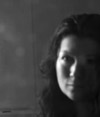 Amy Friend (Canada) Her work has been featured in publications such as Creative Block, EnRoute Magazine, LENS magazine (China), The Walrus, and & Magazine (Israel). She has exhibited both nationally and internationally and has received grants from the Canada Council for the Arts, as well as the Ontario Arts Council. In 2013, she was selected as one of the top 50 photographers in the Critical Mass Photo Competition. Amy’s work has most recently been exhibited in Paris at the Galerie Rivière/Faiveley and in San Francisco at the Cordon/Potts Gallery.
Amy Friend (Canada) Her work has been featured in publications such as Creative Block, EnRoute Magazine, LENS magazine (China), The Walrus, and & Magazine (Israel). She has exhibited both nationally and internationally and has received grants from the Canada Council for the Arts, as well as the Ontario Arts Council. In 2013, she was selected as one of the top 50 photographers in the Critical Mass Photo Competition. Amy’s work has most recently been exhibited in Paris at the Galerie Rivière/Faiveley and in San Francisco at the Cordon/Potts Gallery.
In my use of the photographic medium, I am not specifically concerned with capturing a “concrete” reality. Instead, I aim to use photography as a medium that offers the possibility of exploring the relationship between what is visible and non-visible. I have been working on the Dare alla Luce series over a period of time; initially I responded to a collection of vintage photographs, retrieved from a variety of sources both personal and anonymous. Through hand-manipulated interventions I altered and subsequently re-photographed the images “re-making” photographs that oscillate between what is present and what is absent. I aim to comment on the fragile quality of the photographic object but also on the equal fragility of our lives, our history. All are lost so easily. By playing with the tools of photography, I “re-use” light by allowing it to shine through the holes in the images. In a somewhat playful and yet, literal manner I return the subject of the photographs back to the light, while simultaneously bringing them forward. The images are permanently altered; they are lost and reborn, hence the title, Dare alla Luce, an Italian term meaning, “to bring to the light”.
The photographs have new meaning, despite the mysteries they harbor. The title of each piece is significant; some titles were taken directly from the notations found written on the photographs, yet those without any indication of provenance were titled to reference the nuances of photography as a medium and the manner in which we interact with these images.
As I continued to work on this series, I became more aware of the weight each photograph carries. They display moments of love, excitement, solitude, tranquility and fragments of stories that will remain unknown.
These photographs are fragments of everything and nothing.
















 Amy Friend (Canada) Her work has been featured in publications such as Creative Block, EnRoute Magazine, LENS magazine (China), The Walrus, and & Magazine (Israel). She has exhibited both nationally and internationally and has received grants from the Canada Council for the Arts, as well as the Ontario Arts Council. In 2013, she was selected as one of the top 50 photographers in the Critical Mass Photo Competition. Amy’s work has most recently been exhibited in Paris at the Galerie Rivière/Faiveley and in San Francisco at the Cordon/Potts Gallery.
Amy Friend (Canada) Her work has been featured in publications such as Creative Block, EnRoute Magazine, LENS magazine (China), The Walrus, and & Magazine (Israel). She has exhibited both nationally and internationally and has received grants from the Canada Council for the Arts, as well as the Ontario Arts Council. In 2013, she was selected as one of the top 50 photographers in the Critical Mass Photo Competition. Amy’s work has most recently been exhibited in Paris at the Galerie Rivière/Faiveley and in San Francisco at the Cordon/Potts Gallery.María María Acha-Kutscher

Year: since 2010
Womankind consists of several series of digital photographic collages. These were made using found archival images; images from the internet, magazines, books; and photographs taken by the artist.
The series of Womankind focus on two of the most important moments in women’s history: the British suffrage movement of the early twentieth century, and the introduction of the pill in the 1960s, which contributed significantly to the emancipation of women, transforming their relationships with men.
Womankind seeks to redefine the meaning of the images upon which the history of women has been built since the invention of photography, where traditionally they have been relegated to the background in paternalistic, hegemonic stories. In her collages, María María rescues a female historical memory, reflecting both their political struggles and the complexity of otheir private worlds.
























 María María Acha-Kutscher (Lima-Perú, 1968). Feminist visual artist. Co-directs with Tomás Ruiz-Rivas the experimental art project Antimuseo. Lives in Madrid and works globally. The main focus of her work is woman. Her story, the struggles for emancipation and equality, and the cultural construction of femininity. Her work does not adhere to any particular language or style, nor is it identified with specific techniques or formats.
María María Acha-Kutscher (Lima-Perú, 1968). Feminist visual artist. Co-directs with Tomás Ruiz-Rivas the experimental art project Antimuseo. Lives in Madrid and works globally. The main focus of her work is woman. Her story, the struggles for emancipation and equality, and the cultural construction of femininity. Her work does not adhere to any particular language or style, nor is it identified with specific techniques or formats.
Year: since 2010
Womankind consists of several series of digital photographic collages. These were made using found archival images; images from the internet, magazines, books; and photographs taken by the artist.
The series of Womankind focus on two of the most important moments in women’s history: the British suffrage movement of the early twentieth century, and the introduction of the pill in the 1960s, which contributed significantly to the emancipation of women, transforming their relationships with men.
Womankind seeks to redefine the meaning of the images upon which the history of women has been built since the invention of photography, where traditionally they have been relegated to the background in paternalistic, hegemonic stories. In her collages, María María rescues a female historical memory, reflecting both their political struggles and the complexity of otheir private worlds.
























 María María Acha-Kutscher (Lima-Perú, 1968). Feminist visual artist. Co-directs with Tomás Ruiz-Rivas the experimental art project Antimuseo. Lives in Madrid and works globally. The main focus of her work is woman. Her story, the struggles for emancipation and equality, and the cultural construction of femininity. Her work does not adhere to any particular language or style, nor is it identified with specific techniques or formats.
María María Acha-Kutscher (Lima-Perú, 1968). Feminist visual artist. Co-directs with Tomás Ruiz-Rivas the experimental art project Antimuseo. Lives in Madrid and works globally. The main focus of her work is woman. Her story, the struggles for emancipation and equality, and the cultural construction of femininity. Her work does not adhere to any particular language or style, nor is it identified with specific techniques or formats.Andrew Esiebo
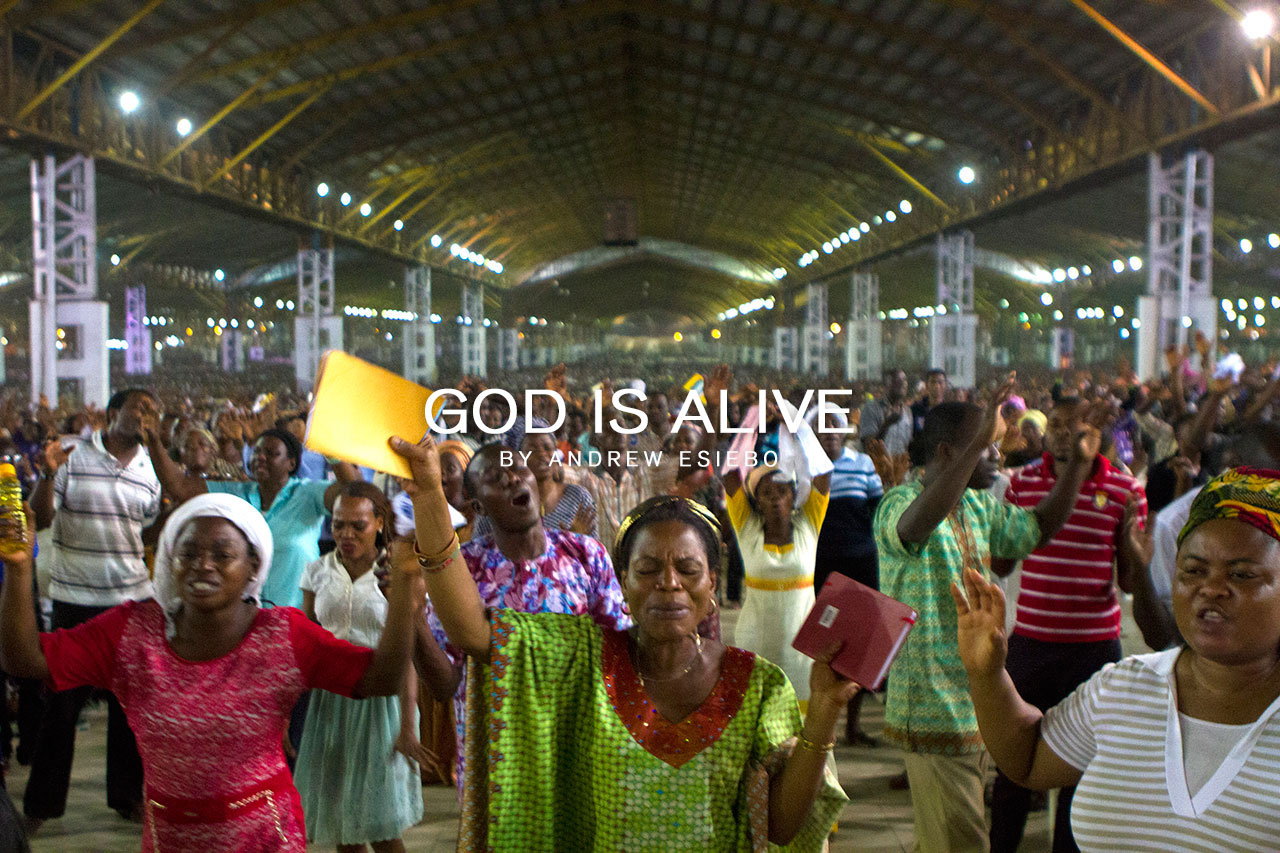
God is at the heart of life in Nigeria. Religious spaces are found in every nook and cranny in the country.
A current wave is the Pentecostal and Charismatic movements that arose in 1970s from the literate environment of Nigerian tertiary colleges and universities. The movements were lead by the mobile and educated youth and kept expanding beyond the walls of the Nigerian tertiary institutions of learning to other places. By the 1970s they had formed linkages with similar movements in United States of America and grew into megachurches. A megachurch can boast of hundred thousands congregation under the same place.
The late 1980s also saw the movements adopting media technologies to propagate their messages, to enlist new members and to promote themselves among the public.
They also adopted some kind of faith principles insisting that every Christian has the capacity to address any personal problems; problems of illness, problems of poverty, stagnation etc.
God is Alive is a visual exploration of the movements’ dynamic, secular codes, emotions, and excessiveness in expressing their faith at various Pentecostal gatherings. These phenomena imply hope, release and success for the faithful.






















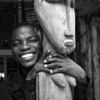 Andrew Esiebo (Nigeria, 1978). Currently living and working in Ibadan, Nigeria. He started his career as a chronicle photographer and has been covering personal projects and tasks mainly in Nigeria and West Africa. He began to explore a new creative territory, involving multimedia practice and research on subjects like sexuality, gender policies, soccer, popular culture and migration. His work has been exhibited on an international basis and has been published in several books, magazines and websites.
Andrew Esiebo (Nigeria, 1978). Currently living and working in Ibadan, Nigeria. He started his career as a chronicle photographer and has been covering personal projects and tasks mainly in Nigeria and West Africa. He began to explore a new creative territory, involving multimedia practice and research on subjects like sexuality, gender policies, soccer, popular culture and migration. His work has been exhibited on an international basis and has been published in several books, magazines and websites.
God is at the heart of life in Nigeria. Religious spaces are found in every nook and cranny in the country.
A current wave is the Pentecostal and Charismatic movements that arose in 1970s from the literate environment of Nigerian tertiary colleges and universities. The movements were lead by the mobile and educated youth and kept expanding beyond the walls of the Nigerian tertiary institutions of learning to other places. By the 1970s they had formed linkages with similar movements in United States of America and grew into megachurches. A megachurch can boast of hundred thousands congregation under the same place.
The late 1980s also saw the movements adopting media technologies to propagate their messages, to enlist new members and to promote themselves among the public.
They also adopted some kind of faith principles insisting that every Christian has the capacity to address any personal problems; problems of illness, problems of poverty, stagnation etc.
God is Alive is a visual exploration of the movements’ dynamic, secular codes, emotions, and excessiveness in expressing their faith at various Pentecostal gatherings. These phenomena imply hope, release and success for the faithful.






















 Andrew Esiebo (Nigeria, 1978). Currently living and working in Ibadan, Nigeria. He started his career as a chronicle photographer and has been covering personal projects and tasks mainly in Nigeria and West Africa. He began to explore a new creative territory, involving multimedia practice and research on subjects like sexuality, gender policies, soccer, popular culture and migration. His work has been exhibited on an international basis and has been published in several books, magazines and websites.
Andrew Esiebo (Nigeria, 1978). Currently living and working in Ibadan, Nigeria. He started his career as a chronicle photographer and has been covering personal projects and tasks mainly in Nigeria and West Africa. He began to explore a new creative territory, involving multimedia practice and research on subjects like sexuality, gender policies, soccer, popular culture and migration. His work has been exhibited on an international basis and has been published in several books, magazines and websites.Jean-Claude Moschetti

This work, Magic on earth, is about traditional secret societies and voodoo in Africa. Many African societies see masks as mediators between the living world and the supernatural world of the dead, ancestors and other entities.
Masks are supposed to come from another world. In Burkina -Faso for example they represent protective spirits that can take animal forms or can appear as strange beings. These spirits watch over a family, clan or community, and, if the rules for their propitiation are followed correctly, provide for the fertility, health, and prosperity.
My main goal , through my pictures, is to show the presence of the supernatural in the daily life, to bring out a part of this mystery . If i need , I reverse, duplicate or mix my pictures in order to get the right feeling. At the same time I try to gather an ethnographic material who show the richness of the artistic expression carried by these societies.


























 Jean-Claude Moschetti (France, 1967). He was trained at the INSAS, the Higher National Institute of Performing Arts and Broadcasting Techniques, in Belgium, and then worked in the film industry. Because of his interest in photography, he decided in 1995 to become an independent press photographer and to work for the French and international press through the agency REA. Currently living between Rennes and Nantes, he makes reports and portraits for the press, private businesses and public agencies.
Jean-Claude Moschetti (France, 1967). He was trained at the INSAS, the Higher National Institute of Performing Arts and Broadcasting Techniques, in Belgium, and then worked in the film industry. Because of his interest in photography, he decided in 1995 to become an independent press photographer and to work for the French and international press through the agency REA. Currently living between Rennes and Nantes, he makes reports and portraits for the press, private businesses and public agencies.
This work, Magic on earth, is about traditional secret societies and voodoo in Africa. Many African societies see masks as mediators between the living world and the supernatural world of the dead, ancestors and other entities.
Masks are supposed to come from another world. In Burkina -Faso for example they represent protective spirits that can take animal forms or can appear as strange beings. These spirits watch over a family, clan or community, and, if the rules for their propitiation are followed correctly, provide for the fertility, health, and prosperity.
My main goal , through my pictures, is to show the presence of the supernatural in the daily life, to bring out a part of this mystery . If i need , I reverse, duplicate or mix my pictures in order to get the right feeling. At the same time I try to gather an ethnographic material who show the richness of the artistic expression carried by these societies.


























 Jean-Claude Moschetti (France, 1967). He was trained at the INSAS, the Higher National Institute of Performing Arts and Broadcasting Techniques, in Belgium, and then worked in the film industry. Because of his interest in photography, he decided in 1995 to become an independent press photographer and to work for the French and international press through the agency REA. Currently living between Rennes and Nantes, he makes reports and portraits for the press, private businesses and public agencies.
Jean-Claude Moschetti (France, 1967). He was trained at the INSAS, the Higher National Institute of Performing Arts and Broadcasting Techniques, in Belgium, and then worked in the film industry. Because of his interest in photography, he decided in 1995 to become an independent press photographer and to work for the French and international press through the agency REA. Currently living between Rennes and Nantes, he makes reports and portraits for the press, private businesses and public agencies.Kostya Smolyaninov

The project Street Theography was created during 2006-2013 in several cities of the Ukraine, Poland and Russia. It is not strange to find people praying in church, but my interest was aroused by the many manifestations of religious feelings in everyday life, on the street. That’s where, during photographic research, I came up with the idea and name for this series. Especially in the street the conflict between the intimate nature of faith and the public, often ostentatious, religiosity strongly appears.
































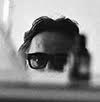 Kostya Smolyaninov (1971). Lives in Lviv, Ukraine. Photographer and curator. Solo Exhibitions: “On Every Street”, Dzyga Flat 35 (Lviv, Ukraine), 2007; “Street Theography”, Fot-Art Gallery (Szczecin, Poland), 2008; “Generation”, Dzyga Gallery (Lviv, Ukraine), 2008; “Street Theography”,Camera Gallery (Kiev, Ukraine), 2009; “Jazz Bez. Intro”, 5х5 (Lviv, Ukraine), 2009; “2” en Art Palace (Lviv, Ukraine), 2010; “Album” en BWA Gallery (Rzesów, Poland), 2011; “Universal Spaces” en Dzyga Gallery (Lviv, Ukraine), 2012; "2" en Camera Gallery (Kiev, Ukraine), 2012.
Kostya Smolyaninov (1971). Lives in Lviv, Ukraine. Photographer and curator. Solo Exhibitions: “On Every Street”, Dzyga Flat 35 (Lviv, Ukraine), 2007; “Street Theography”, Fot-Art Gallery (Szczecin, Poland), 2008; “Generation”, Dzyga Gallery (Lviv, Ukraine), 2008; “Street Theography”,Camera Gallery (Kiev, Ukraine), 2009; “Jazz Bez. Intro”, 5х5 (Lviv, Ukraine), 2009; “2” en Art Palace (Lviv, Ukraine), 2010; “Album” en BWA Gallery (Rzesów, Poland), 2011; “Universal Spaces” en Dzyga Gallery (Lviv, Ukraine), 2012; "2" en Camera Gallery (Kiev, Ukraine), 2012.
The project Street Theography was created during 2006-2013 in several cities of the Ukraine, Poland and Russia. It is not strange to find people praying in church, but my interest was aroused by the many manifestations of religious feelings in everyday life, on the street. That’s where, during photographic research, I came up with the idea and name for this series. Especially in the street the conflict between the intimate nature of faith and the public, often ostentatious, religiosity strongly appears.
































 Kostya Smolyaninov (1971). Lives in Lviv, Ukraine. Photographer and curator. Solo Exhibitions: “On Every Street”, Dzyga Flat 35 (Lviv, Ukraine), 2007; “Street Theography”, Fot-Art Gallery (Szczecin, Poland), 2008; “Generation”, Dzyga Gallery (Lviv, Ukraine), 2008; “Street Theography”,Camera Gallery (Kiev, Ukraine), 2009; “Jazz Bez. Intro”, 5х5 (Lviv, Ukraine), 2009; “2” en Art Palace (Lviv, Ukraine), 2010; “Album” en BWA Gallery (Rzesów, Poland), 2011; “Universal Spaces” en Dzyga Gallery (Lviv, Ukraine), 2012; "2" en Camera Gallery (Kiev, Ukraine), 2012.
Kostya Smolyaninov (1971). Lives in Lviv, Ukraine. Photographer and curator. Solo Exhibitions: “On Every Street”, Dzyga Flat 35 (Lviv, Ukraine), 2007; “Street Theography”, Fot-Art Gallery (Szczecin, Poland), 2008; “Generation”, Dzyga Gallery (Lviv, Ukraine), 2008; “Street Theography”,Camera Gallery (Kiev, Ukraine), 2009; “Jazz Bez. Intro”, 5х5 (Lviv, Ukraine), 2009; “2” en Art Palace (Lviv, Ukraine), 2010; “Album” en BWA Gallery (Rzesów, Poland), 2011; “Universal Spaces” en Dzyga Gallery (Lviv, Ukraine), 2012; "2" en Camera Gallery (Kiev, Ukraine), 2012.Kevin Weir
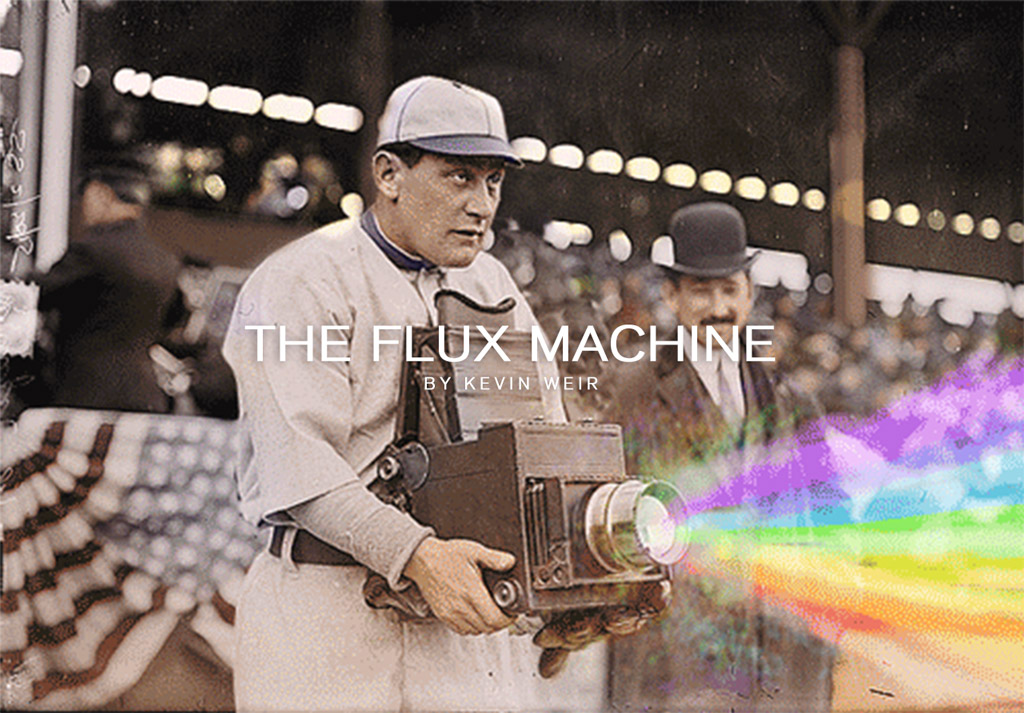






















Kevin Weir’s Flux Machine swivels between two lines closely related to the theme of temporality: using the format of animated GIF, he gives static images infinite and recurrent movement, and integrating narrative elements into archival photographs he reinterprets its meaning. The resulting microfictions offer readings at different levels questioning our usual interpretation of archival materials and leading us to crossroads between the historic moment and the imagined action.
 Kevin Weir (USA) Grew up in the woods of rural upstate New York, just outside of Binghamton. He went to Penn State for his undergrad. Studied abroad in Australia. He got a masters at the VCU Brandcenter and, now, works as an art director at Droga5 in NYC. He is known worldwide for his animation project The Flux Machine, for which he uses the Bain Collection at the Library of Congress.
Kevin Weir (USA) Grew up in the woods of rural upstate New York, just outside of Binghamton. He went to Penn State for his undergrad. Studied abroad in Australia. He got a masters at the VCU Brandcenter and, now, works as an art director at Droga5 in NYC. He is known worldwide for his animation project The Flux Machine, for which he uses the Bain Collection at the Library of Congress.






















Kevin Weir’s Flux Machine swivels between two lines closely related to the theme of temporality: using the format of animated GIF, he gives static images infinite and recurrent movement, and integrating narrative elements into archival photographs he reinterprets its meaning. The resulting microfictions offer readings at different levels questioning our usual interpretation of archival materials and leading us to crossroads between the historic moment and the imagined action.
 Kevin Weir (USA) Grew up in the woods of rural upstate New York, just outside of Binghamton. He went to Penn State for his undergrad. Studied abroad in Australia. He got a masters at the VCU Brandcenter and, now, works as an art director at Droga5 in NYC. He is known worldwide for his animation project The Flux Machine, for which he uses the Bain Collection at the Library of Congress.
Kevin Weir (USA) Grew up in the woods of rural upstate New York, just outside of Binghamton. He went to Penn State for his undergrad. Studied abroad in Australia. He got a masters at the VCU Brandcenter and, now, works as an art director at Droga5 in NYC. He is known worldwide for his animation project The Flux Machine, for which he uses the Bain Collection at the Library of Congress.Pelle Cass

This work both orders the world and exaggerates its chaos. With the camera on a tripod, I take many photos, leave in the best ones and omit the rest. The photographs are composed but they have not been changed, only selected. My work is about the strangeness of time, about how people really look, and about the surprising world that is only visible with a camera. I want to capture more life, more people, more time, and more truth in my photographs. Photography, with its ability to record everything in front of the lens, is just the beginning of this process. Selected People is inspired by surveillance photography, Walker Evans’s hidden-camera subway portraits, and P.L. di Corcia’s Head series; works in which the camera waits for its subjects to come into view. My work also looks at city life from a fixed position, with the difference that each image contains an hour’s time and is a composition of hundreds of exposures. To do this, I put the camera on a tripod, and take hundreds of pictures as people pass by. Back in the studio, I choose what to leave in and make no further alterations. The process mirrors the way the mind focuses attention on one thing but not on another. A person thinking about photography, for example, tends to notice people with cameras over those without. This kind of selection allows me to take objective facts–the faces and bodies of people on the street–and make something new and more subjective out of them, simply by sorting them. Above all, I want to show a surprising world that is visible only with a camera.

















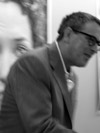 Pelle Cass (Brookline, MA). He has presented solo shows at the Houston Center for Photography; Gallery Kayafas, Boston; Stux Gallery, Boston; Frank Marino Gallery, NYC; the Griffin Museum of Photography; and the Fogg Art Museum’s print room. His work is in the collections of the Fogg Art Museum, the Addison Gallery of American Art, the Polaroid Collection, the DeCordova Museum, the Danforth Museum of Art, the Peabody Essex Museum, the Museum of Fine Arts, Houston, and the Lehigh University Art Galleries, among others. He was a Winner: Top 50, Critical Mass, Photolucida, Portland, OR, in 2008 and 2009, was awarded fellowships by the Corporation of Yaddo in 2010 and 2012, and won an Artist’s Resource Trust Award (Berkshire Taconic Foundation) in 2012. He lives in Brookline, Massachusetts.
Pelle Cass (Brookline, MA). He has presented solo shows at the Houston Center for Photography; Gallery Kayafas, Boston; Stux Gallery, Boston; Frank Marino Gallery, NYC; the Griffin Museum of Photography; and the Fogg Art Museum’s print room. His work is in the collections of the Fogg Art Museum, the Addison Gallery of American Art, the Polaroid Collection, the DeCordova Museum, the Danforth Museum of Art, the Peabody Essex Museum, the Museum of Fine Arts, Houston, and the Lehigh University Art Galleries, among others. He was a Winner: Top 50, Critical Mass, Photolucida, Portland, OR, in 2008 and 2009, was awarded fellowships by the Corporation of Yaddo in 2010 and 2012, and won an Artist’s Resource Trust Award (Berkshire Taconic Foundation) in 2012. He lives in Brookline, Massachusetts.
This work both orders the world and exaggerates its chaos. With the camera on a tripod, I take many photos, leave in the best ones and omit the rest. The photographs are composed but they have not been changed, only selected. My work is about the strangeness of time, about how people really look, and about the surprising world that is only visible with a camera. I want to capture more life, more people, more time, and more truth in my photographs. Photography, with its ability to record everything in front of the lens, is just the beginning of this process. Selected People is inspired by surveillance photography, Walker Evans’s hidden-camera subway portraits, and P.L. di Corcia’s Head series; works in which the camera waits for its subjects to come into view. My work also looks at city life from a fixed position, with the difference that each image contains an hour’s time and is a composition of hundreds of exposures. To do this, I put the camera on a tripod, and take hundreds of pictures as people pass by. Back in the studio, I choose what to leave in and make no further alterations. The process mirrors the way the mind focuses attention on one thing but not on another. A person thinking about photography, for example, tends to notice people with cameras over those without. This kind of selection allows me to take objective facts–the faces and bodies of people on the street–and make something new and more subjective out of them, simply by sorting them. Above all, I want to show a surprising world that is visible only with a camera.

















 Pelle Cass (Brookline, MA). He has presented solo shows at the Houston Center for Photography; Gallery Kayafas, Boston; Stux Gallery, Boston; Frank Marino Gallery, NYC; the Griffin Museum of Photography; and the Fogg Art Museum’s print room. His work is in the collections of the Fogg Art Museum, the Addison Gallery of American Art, the Polaroid Collection, the DeCordova Museum, the Danforth Museum of Art, the Peabody Essex Museum, the Museum of Fine Arts, Houston, and the Lehigh University Art Galleries, among others. He was a Winner: Top 50, Critical Mass, Photolucida, Portland, OR, in 2008 and 2009, was awarded fellowships by the Corporation of Yaddo in 2010 and 2012, and won an Artist’s Resource Trust Award (Berkshire Taconic Foundation) in 2012. He lives in Brookline, Massachusetts.
Pelle Cass (Brookline, MA). He has presented solo shows at the Houston Center for Photography; Gallery Kayafas, Boston; Stux Gallery, Boston; Frank Marino Gallery, NYC; the Griffin Museum of Photography; and the Fogg Art Museum’s print room. His work is in the collections of the Fogg Art Museum, the Addison Gallery of American Art, the Polaroid Collection, the DeCordova Museum, the Danforth Museum of Art, the Peabody Essex Museum, the Museum of Fine Arts, Houston, and the Lehigh University Art Galleries, among others. He was a Winner: Top 50, Critical Mass, Photolucida, Portland, OR, in 2008 and 2009, was awarded fellowships by the Corporation of Yaddo in 2010 and 2012, and won an Artist’s Resource Trust Award (Berkshire Taconic Foundation) in 2012. He lives in Brookline, Massachusetts.Gabriel de la Mora

This series of altered photographs comes from a set of negatives that was destroyed when the warehouse where they had been stored for decades was flooded. This is why some of the negatives were stuck together, some of them showing two different takes of the same person and others two or three different people. They are negatives of portraits taken in 1948 and 1949 by Víctor Villamil Vilón at Cano Photography Studios, later called Vilón Photography Studios in Bogotá, Colombia. The images were printed on silver gel with fibrous paper in Mexico City and subsequently altered and framed. The artist begins his work by tearing off pieces of the photo.
Time and light do the rest, erasing the photographic image completely and leaving a monochrome surface. Only then is the work finished. Therefore 50, 100 or 300 years will have to pass, depending on the conditions in which the work is found. The artist never completes the piece and will surely never see it finished. This series is a parallel to the altered space entitled Pan-American Exhibition at NC ARTE.

























 Gabriel de la Mora (Mexico 1968). Studied a masters in painting, photography and video at the Pratt Institute in New York (2001-2003) and a bachelors in architecture at the Universidad Anáhuac del Norte (1987-1991) in Mexico City. He is currently a member of the Sistema Nacional de Creadores de Arte (2013-2015) and has received a number of awards and grants including the Primer Premio de la VII Bienal de Monterrey FEMSA, the Garcia Robles Fulbright Grant and the Jacques and Natasha Gelman Grant among others. His work as been shown in Mexico and abroad both individually and collectively.
Gabriel de la Mora (Mexico 1968). Studied a masters in painting, photography and video at the Pratt Institute in New York (2001-2003) and a bachelors in architecture at the Universidad Anáhuac del Norte (1987-1991) in Mexico City. He is currently a member of the Sistema Nacional de Creadores de Arte (2013-2015) and has received a number of awards and grants including the Primer Premio de la VII Bienal de Monterrey FEMSA, the Garcia Robles Fulbright Grant and the Jacques and Natasha Gelman Grant among others. His work as been shown in Mexico and abroad both individually and collectively.ZZ. In the project called Archive V.V. 1948 -49 how do you establish the photograph/time relationship? How does it affect the image both as an external and intrinsic element?
GM. Photographic technique is a constantly changing process. Depending upon the passage of time and light, on how the photo has been exposed to these two factors, it can slowly fade and begin to disappear. Which initially worried me for this project. But I think that later this inevitable factor became a starting point for various series in which I used photography as primary or supporting material.
In most of my work, photography is an important element, whether as a file or a document, or a starting point as it was for Willy Kautz in his work shown at the Amparo Museum from October 2014 to February 2015 under the title "What watches us that we don’t see.” The starting point in this exhibit was how an image becomes monochromatic and how a monochrome can become an image.
Although I take photographs to document pieces and processes, amongst many other things, I like to work with vintage photographs from the late 19th to the late 20th century. I buy archives, classify them and then begin my explorations. For the Archive V.V. 1948-49 project I used destroyed negatives for the first time. The alterations were both accidental and due to the passage of time, which produced astounding results.
The Vilón Archive series began in 2012 while I was preparing for my first altered space project at the NC ARTE gallery in Bogotá Colombia. As an alternative activity to the show called Pan-American Exhibition curated by Willy Kautz, I visited an old photography studio near the NC ARTE gallery. I was hoping to find vintage portraits taken in Bogotá in 1948-1949.
Victor Vilón’s children, Germán and Patricia Vilón, who owned the Vilón Photography Studio, told me that although they had no old photographs they did have some negatives which they would look for to show me. Two days later I turned up punctually for our appointment and both Patricia and Germán had a look of utter frustration: they showed me a cardboard box containing hundreds of negatives that had been destroyed by a flood in the warehouse where they had been stored, which no-one had noticed. Patricia showed me various negatives that were stuck together and would break when separated and told me they were going to throw it all away. When I saw some of the negatives, I found them far more interesting than they would have been if they had not got wet. So I asked Germán if they could print the negatives in their destroyed state and he told me that they could, but that they would turn out badly. I chose a few and asked for examples. A couple of days later, these examples exceeded my expectations. Previously, I would buy vintage photographs from Mexican movies and alter them by randomly tearing part of the film to transform the narrative and configuration through a process of abstraction and destruction.
Before destroying each image I would scan both sides so that each altered photograph could be added to my digital archives.
The destroyed negatives from Archive V.V. had not been altered by me, but by an accident that destroyed them over time, so the artistic process for series like the one on Mexican movies was carried out by time rather than by me. The result is simply amazing. To rescue the negatives from the garbage I asked German and Patricia to sell them to me to keep in Mexico where I could continue experimenting with the series of images.
ZZ. How much do you intervene in the construction of a photographic image and at what point is it beyond your control?
GM. As an artist I like to have control over certain pieces or series, but I also like to lose absolute control over other series in particular, or occasionally combine both: control and randomness.
With regards to the destroyed negatives, or Archive V.V. 1948-49, the majority of alterations were made by the flood and time and the results were the starting point for a new series. When printed, the images were extraordinary, unique, and I did not intervene in them at all except for finding and recovering them. It was like a type of assisted Ready Made, as Francisco Reyes Palma so aptly called it. Once the photos had been printed, I altered them again by tearing part of the photographic film off and leaving the fragments at the bottom of the frame. This begins a process that, depending on the conditions in which the photo is stored, time and light, will cause the image to entirely disappear in maybe 50, 100 or more years, transforming the photo into a monochrome white surface. When this finally happens, the piece will be completed. “The artist only begins the piece, but will never see it finished as its process continues over time even after the artist’s death.”
Back in Mexico, I went to a photography laboratory to print the negatives I had chosen on fiber paper in a similar way. Once they were printed, but before framing them, I altered them randomly, tearing bits of photographic film off and saving them so that after the photo had been framed, they would be at the bottom of the frame.
What most interests me is what happens after the first intervention when the destroyed negative is printed. I intervene again by tearing off small pieces of the image, thereby beginning my piece of work, since time, light and varied storage conditions will complete the piece.
ZZ. When the object mediates between the artist and the spectator, what type of reflection does it incite?
GM. At the end of the day, everything vanishes. Nothing is eternal and everything is subject to constant change and transformation. Art is neither created nor destroyed, only transformed.
In my work, I like to introduce the works. They do everything. There is a an interesting visual, formal and technical factor that makes an initial, perhaps more emotional impact. Afterwards, you can explore what goes on behind the process, and the work itself has various levels of information where one question leads to another, and so on, indefinitely.
When something attracts your attention and you like it but it also makes you think, for me, that is the point where the work becomes whole. Each person will have a different opinion or reaction depending on the level and type of previous information they possess. The images or works in this series, for example, have received differing opinions and reflections. In some people they elicit nostalgia for an era, a person who no longer exists or who died years ago; for others, it produces a certain mystery, or even fear, since some of the faces or images are rather ghostlike.
Personally, I believe that the images are powerful in every respect. They have an extraordinary composition and were, in a way, part of an archive which, when it was destroyed, fulfilled its destiny by becoming waste. This is a footnote for me as an artist, knowing that what comes at the end of one thing can be the beginning of another. This waste or residual material can be transformed into artwork.
When two or more negatives in the archive are stuck together and then break and are fragmented into other images, the way I print them turns them into something extraordinary. They have been altered by time, through a naturally destructive process, making the image into an abstraction with a strange composition. The people still exist in them, or their presence is registered, together with a whole era. Thus the images are historic documents that are transformed into something else.
The original author of these portraits was Don Victor Villamil Vilón, and now I am the author. I love to find new ways of experimenting with photography. I did not originally take these photographs, but I did rescue them from the becoming garbage after they had been destroyed in a flood and now they are prime examples for exploring image through records, archives and documents.

This series of altered photographs comes from a set of negatives that was destroyed when the warehouse where they had been stored for decades was flooded. This is why some of the negatives were stuck together, some of them showing two different takes of the same person and others two or three different people. They are negatives of portraits taken in 1948 and 1949 by Víctor Villamil Vilón at Cano Photography Studios, later called Vilón Photography Studios in Bogotá, Colombia. The images were printed on silver gel with fibrous paper in Mexico City and subsequently altered and framed. The artist begins his work by tearing off pieces of the photo.
Time and light do the rest, erasing the photographic image completely and leaving a monochrome surface. Only then is the work finished. Therefore 50, 100 or 300 years will have to pass, depending on the conditions in which the work is found. The artist never completes the piece and will surely never see it finished. This series is a parallel to the altered space entitled Pan-American Exhibition at NC ARTE.

























 Gabriel de la Mora (Mexico 1968). Studied a masters in painting, photography and video at the Pratt Institute in New York (2001-2003) and a bachelors in architecture at the Universidad Anáhuac del Norte (1987-1991) in Mexico City. He is currently a member of the Sistema Nacional de Creadores de Arte (2013-2015) and has received a number of awards and grants including the Primer Premio de la VII Bienal de Monterrey FEMSA, the Garcia Robles Fulbright Grant and the Jacques and Natasha Gelman Grant among others. His work as been shown in Mexico and abroad both individually and collectively.
Gabriel de la Mora (Mexico 1968). Studied a masters in painting, photography and video at the Pratt Institute in New York (2001-2003) and a bachelors in architecture at the Universidad Anáhuac del Norte (1987-1991) in Mexico City. He is currently a member of the Sistema Nacional de Creadores de Arte (2013-2015) and has received a number of awards and grants including the Primer Premio de la VII Bienal de Monterrey FEMSA, the Garcia Robles Fulbright Grant and the Jacques and Natasha Gelman Grant among others. His work as been shown in Mexico and abroad both individually and collectively.ZZ. In the project called Archive V.V. 1948 -49 how do you establish the photograph/time relationship? How does it affect the image both as an external and intrinsic element?
GM. Photographic technique is a constantly changing process. Depending upon the passage of time and light, on how the photo has been exposed to these two factors, it can slowly fade and begin to disappear. Which initially worried me for this project. But I think that later this inevitable factor became a starting point for various series in which I used photography as primary or supporting material.
In most of my work, photography is an important element, whether as a file or a document, or a starting point as it was for Willy Kautz in his work shown at the Amparo Museum from October 2014 to February 2015 under the title "What watches us that we don’t see.” The starting point in this exhibit was how an image becomes monochromatic and how a monochrome can become an image.
Although I take photographs to document pieces and processes, amongst many other things, I like to work with vintage photographs from the late 19th to the late 20th century. I buy archives, classify them and then begin my explorations. For the Archive V.V. 1948-49 project I used destroyed negatives for the first time. The alterations were both accidental and due to the passage of time, which produced astounding results.
The Vilón Archive series began in 2012 while I was preparing for my first altered space project at the NC ARTE gallery in Bogotá Colombia. As an alternative activity to the show called Pan-American Exhibition curated by Willy Kautz, I visited an old photography studio near the NC ARTE gallery. I was hoping to find vintage portraits taken in Bogotá in 1948-1949.
Victor Vilón’s children, Germán and Patricia Vilón, who owned the Vilón Photography Studio, told me that although they had no old photographs they did have some negatives which they would look for to show me. Two days later I turned up punctually for our appointment and both Patricia and Germán had a look of utter frustration: they showed me a cardboard box containing hundreds of negatives that had been destroyed by a flood in the warehouse where they had been stored, which no-one had noticed. Patricia showed me various negatives that were stuck together and would break when separated and told me they were going to throw it all away. When I saw some of the negatives, I found them far more interesting than they would have been if they had not got wet. So I asked Germán if they could print the negatives in their destroyed state and he told me that they could, but that they would turn out badly. I chose a few and asked for examples. A couple of days later, these examples exceeded my expectations. Previously, I would buy vintage photographs from Mexican movies and alter them by randomly tearing part of the film to transform the narrative and configuration through a process of abstraction and destruction.
Before destroying each image I would scan both sides so that each altered photograph could be added to my digital archives.
The destroyed negatives from Archive V.V. had not been altered by me, but by an accident that destroyed them over time, so the artistic process for series like the one on Mexican movies was carried out by time rather than by me. The result is simply amazing. To rescue the negatives from the garbage I asked German and Patricia to sell them to me to keep in Mexico where I could continue experimenting with the series of images.
ZZ. How much do you intervene in the construction of a photographic image and at what point is it beyond your control?
GM. As an artist I like to have control over certain pieces or series, but I also like to lose absolute control over other series in particular, or occasionally combine both: control and randomness.
With regards to the destroyed negatives, or Archive V.V. 1948-49, the majority of alterations were made by the flood and time and the results were the starting point for a new series. When printed, the images were extraordinary, unique, and I did not intervene in them at all except for finding and recovering them. It was like a type of assisted Ready Made, as Francisco Reyes Palma so aptly called it. Once the photos had been printed, I altered them again by tearing part of the photographic film off and leaving the fragments at the bottom of the frame. This begins a process that, depending on the conditions in which the photo is stored, time and light, will cause the image to entirely disappear in maybe 50, 100 or more years, transforming the photo into a monochrome white surface. When this finally happens, the piece will be completed. “The artist only begins the piece, but will never see it finished as its process continues over time even after the artist’s death.”
Back in Mexico, I went to a photography laboratory to print the negatives I had chosen on fiber paper in a similar way. Once they were printed, but before framing them, I altered them randomly, tearing bits of photographic film off and saving them so that after the photo had been framed, they would be at the bottom of the frame.
What most interests me is what happens after the first intervention when the destroyed negative is printed. I intervene again by tearing off small pieces of the image, thereby beginning my piece of work, since time, light and varied storage conditions will complete the piece.
ZZ. When the object mediates between the artist and the spectator, what type of reflection does it incite?
GM. At the end of the day, everything vanishes. Nothing is eternal and everything is subject to constant change and transformation. Art is neither created nor destroyed, only transformed.
In my work, I like to introduce the works. They do everything. There is a an interesting visual, formal and technical factor that makes an initial, perhaps more emotional impact. Afterwards, you can explore what goes on behind the process, and the work itself has various levels of information where one question leads to another, and so on, indefinitely.
When something attracts your attention and you like it but it also makes you think, for me, that is the point where the work becomes whole. Each person will have a different opinion or reaction depending on the level and type of previous information they possess. The images or works in this series, for example, have received differing opinions and reflections. In some people they elicit nostalgia for an era, a person who no longer exists or who died years ago; for others, it produces a certain mystery, or even fear, since some of the faces or images are rather ghostlike.
Personally, I believe that the images are powerful in every respect. They have an extraordinary composition and were, in a way, part of an archive which, when it was destroyed, fulfilled its destiny by becoming waste. This is a footnote for me as an artist, knowing that what comes at the end of one thing can be the beginning of another. This waste or residual material can be transformed into artwork.
When two or more negatives in the archive are stuck together and then break and are fragmented into other images, the way I print them turns them into something extraordinary. They have been altered by time, through a naturally destructive process, making the image into an abstraction with a strange composition. The people still exist in them, or their presence is registered, together with a whole era. Thus the images are historic documents that are transformed into something else.
The original author of these portraits was Don Victor Villamil Vilón, and now I am the author. I love to find new ways of experimenting with photography. I did not originally take these photographs, but I did rescue them from the becoming garbage after they had been destroyed in a flood and now they are prime examples for exploring image through records, archives and documents.
Andrea Dorliguzzo

In 2013, Andrea Dorliguzzo started with his rephotography project Roma Ieri Oggi (Rome Yesterday Today). Driven by his passion for photography and his admiration for Rome, he started to collect old photographs of the city and combined these with contemporary ones, taken at exactly the same spot. In this way, the past and the present are brought together, causing a thrilling historical sensation which reminds us of all the great stories that the city has to tell.




















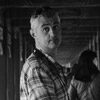 Andrea Dorliguzzo (Italy) was born in Friuli, in the north-east part of Italy. A few years ago, he moved to Rome. His passion for photography was born quite recently. Over the last years, he had the luck of traveling a lot and bringing home an unimaginable number of pictures and memories. Regarding his photos, he is very critical and only a small selection is published on his photo blog.
Andrea Dorliguzzo (Italy) was born in Friuli, in the north-east part of Italy. A few years ago, he moved to Rome. His passion for photography was born quite recently. Over the last years, he had the luck of traveling a lot and bringing home an unimaginable number of pictures and memories. Regarding his photos, he is very critical and only a small selection is published on his photo blog.
In 2013, Andrea Dorliguzzo started with his rephotography project Roma Ieri Oggi (Rome Yesterday Today). Driven by his passion for photography and his admiration for Rome, he started to collect old photographs of the city and combined these with contemporary ones, taken at exactly the same spot. In this way, the past and the present are brought together, causing a thrilling historical sensation which reminds us of all the great stories that the city has to tell.




















 Andrea Dorliguzzo (Italy) was born in Friuli, in the north-east part of Italy. A few years ago, he moved to Rome. His passion for photography was born quite recently. Over the last years, he had the luck of traveling a lot and bringing home an unimaginable number of pictures and memories. Regarding his photos, he is very critical and only a small selection is published on his photo blog.
Andrea Dorliguzzo (Italy) was born in Friuli, in the north-east part of Italy. A few years ago, he moved to Rome. His passion for photography was born quite recently. Over the last years, he had the luck of traveling a lot and bringing home an unimaginable number of pictures and memories. Regarding his photos, he is very critical and only a small selection is published on his photo blog.Eduardo Muñoz























Traveling through his memories and belongings, Eduardo Muñoz Ordoqui constructs worlds and scenarios that are situated in indefinite space-times. Cautiously merging places and occasions, he composes in his series Low Tides, Portable Worlds and Without Rest photos that involve projected images, as well as objects and their reflections. He combines the tangible and the material to create a visual journey that evokes feelings of displacement, migration and uncertainty. The images tell the story of the search for meaning among places and memories.
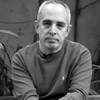 Eduardo Muñoz Ordoqui (Cuba, 1964). Photographer. He received a Bachelor in Fine Arts degree in History of Art from the University of Havana in 1990 and a Master in Fine Arts in Studio Art from the University of Texas at Austin in 2005. He has taught photography for more than nine years in St. Edward’s University at Austin, Texas, where he is currently a Faculty Associate at the Department of Visual Studies. Muñoz-Ordoqui’s photographic work has been exhibited in solo and group shows in Europe, Latin America, China, and United States. He received a John Simon Guggenheim Memorial Foundation Fellowship in 1997, a Cintas Foundation Fellowship in 1998 and in 2007 was chosen for the Artpace International Artist-in-Residence program in San Antonio, Texas, USA. His photographs are held in private and institutional collections in the Americas and Europe.
Eduardo Muñoz Ordoqui (Cuba, 1964). Photographer. He received a Bachelor in Fine Arts degree in History of Art from the University of Havana in 1990 and a Master in Fine Arts in Studio Art from the University of Texas at Austin in 2005. He has taught photography for more than nine years in St. Edward’s University at Austin, Texas, where he is currently a Faculty Associate at the Department of Visual Studies. Muñoz-Ordoqui’s photographic work has been exhibited in solo and group shows in Europe, Latin America, China, and United States. He received a John Simon Guggenheim Memorial Foundation Fellowship in 1997, a Cintas Foundation Fellowship in 1998 and in 2007 was chosen for the Artpace International Artist-in-Residence program in San Antonio, Texas, USA. His photographs are held in private and institutional collections in the Americas and Europe.






















Traveling through his memories and belongings, Eduardo Muñoz Ordoqui constructs worlds and scenarios that are situated in indefinite space-times. Cautiously merging places and occasions, he composes in his series Low Tides, Portable Worlds and Without Rest photos that involve projected images, as well as objects and their reflections. He combines the tangible and the material to create a visual journey that evokes feelings of displacement, migration and uncertainty. The images tell the story of the search for meaning among places and memories.
 Eduardo Muñoz Ordoqui (Cuba, 1964). Photographer. He received a Bachelor in Fine Arts degree in History of Art from the University of Havana in 1990 and a Master in Fine Arts in Studio Art from the University of Texas at Austin in 2005. He has taught photography for more than nine years in St. Edward’s University at Austin, Texas, where he is currently a Faculty Associate at the Department of Visual Studies. Muñoz-Ordoqui’s photographic work has been exhibited in solo and group shows in Europe, Latin America, China, and United States. He received a John Simon Guggenheim Memorial Foundation Fellowship in 1997, a Cintas Foundation Fellowship in 1998 and in 2007 was chosen for the Artpace International Artist-in-Residence program in San Antonio, Texas, USA. His photographs are held in private and institutional collections in the Americas and Europe.
Eduardo Muñoz Ordoqui (Cuba, 1964). Photographer. He received a Bachelor in Fine Arts degree in History of Art from the University of Havana in 1990 and a Master in Fine Arts in Studio Art from the University of Texas at Austin in 2005. He has taught photography for more than nine years in St. Edward’s University at Austin, Texas, where he is currently a Faculty Associate at the Department of Visual Studies. Muñoz-Ordoqui’s photographic work has been exhibited in solo and group shows in Europe, Latin America, China, and United States. He received a John Simon Guggenheim Memorial Foundation Fellowship in 1997, a Cintas Foundation Fellowship in 1998 and in 2007 was chosen for the Artpace International Artist-in-Residence program in San Antonio, Texas, USA. His photographs are held in private and institutional collections in the Americas and Europe.Alvaro Deprit

At home I always used to linger with curiosity at an old photograph of some of my Andalusian relatives. With the passing of years this photograph has given me an image of how I think Andalusia might be.
Al-Andalus is the result of approximately three years of research in the south of Spain, an area I did not know nor in which I have lived, but which is my family’s place of origin and current place of residence.
My initial interest was in the tension I perceived between tradition and the marks of the global world. Andalusia is the result of a complex cultural stratification, derived from the passage of civilisations which, over time, gave life to a hybrid identity capable of containing within it the stereotypical traits of Spanish culture.
Journeying through Andalusia now that it has been hit hard by the economic crisis has made me reflect on the collision of the diverse elements in this land – a land which, as I see it, has shown itself to be hanging in the balance, almost in a state between reality and fiction as the background of a movie.
My intention has not been to reproduce the tangible aspects of a place, but to give shape to a body of memories and impressions born of my personal history or of something unconcluded. Concentrated in the images are visible apparitions whose existence is a mystery, while on the other hand, the mystery is something real in the mind, through the repeating, varying, developing and transposing elements of the memory.
































 Alvaro Deprit (Madrid). Has been living in Italy since 2004. He studied German Philology at the Complutense University of Madrid and at the Otto Friedrich University of Bamberg, Germany. He also studied Sociology at the University d’Annunzio in Chieti, Italy. Alvaro’s work has been exhibited in festivals and galleries all over the world and has been published in international magazines. He won the PHotoEspaña OjodePez Human Values Award, the BJP’s International Photography Award and the Viewbook Photostory Contest, and he was a finalist in Voies Off Arles, Leica Oskar Barnack Award and Sony Award.
Alvaro Deprit (Madrid). Has been living in Italy since 2004. He studied German Philology at the Complutense University of Madrid and at the Otto Friedrich University of Bamberg, Germany. He also studied Sociology at the University d’Annunzio in Chieti, Italy. Alvaro’s work has been exhibited in festivals and galleries all over the world and has been published in international magazines. He won the PHotoEspaña OjodePez Human Values Award, the BJP’s International Photography Award and the Viewbook Photostory Contest, and he was a finalist in Voies Off Arles, Leica Oskar Barnack Award and Sony Award.
At home I always used to linger with curiosity at an old photograph of some of my Andalusian relatives. With the passing of years this photograph has given me an image of how I think Andalusia might be.
Al-Andalus is the result of approximately three years of research in the south of Spain, an area I did not know nor in which I have lived, but which is my family’s place of origin and current place of residence.
My initial interest was in the tension I perceived between tradition and the marks of the global world. Andalusia is the result of a complex cultural stratification, derived from the passage of civilisations which, over time, gave life to a hybrid identity capable of containing within it the stereotypical traits of Spanish culture.
Journeying through Andalusia now that it has been hit hard by the economic crisis has made me reflect on the collision of the diverse elements in this land – a land which, as I see it, has shown itself to be hanging in the balance, almost in a state between reality and fiction as the background of a movie.
My intention has not been to reproduce the tangible aspects of a place, but to give shape to a body of memories and impressions born of my personal history or of something unconcluded. Concentrated in the images are visible apparitions whose existence is a mystery, while on the other hand, the mystery is something real in the mind, through the repeating, varying, developing and transposing elements of the memory.
































 Alvaro Deprit (Madrid). Has been living in Italy since 2004. He studied German Philology at the Complutense University of Madrid and at the Otto Friedrich University of Bamberg, Germany. He also studied Sociology at the University d’Annunzio in Chieti, Italy. Alvaro’s work has been exhibited in festivals and galleries all over the world and has been published in international magazines. He won the PHotoEspaña OjodePez Human Values Award, the BJP’s International Photography Award and the Viewbook Photostory Contest, and he was a finalist in Voies Off Arles, Leica Oskar Barnack Award and Sony Award.
Alvaro Deprit (Madrid). Has been living in Italy since 2004. He studied German Philology at the Complutense University of Madrid and at the Otto Friedrich University of Bamberg, Germany. He also studied Sociology at the University d’Annunzio in Chieti, Italy. Alvaro’s work has been exhibited in festivals and galleries all over the world and has been published in international magazines. He won the PHotoEspaña OjodePez Human Values Award, the BJP’s International Photography Award and the Viewbook Photostory Contest, and he was a finalist in Voies Off Arles, Leica Oskar Barnack Award and Sony Award.Kent Krugh

This body of work, using linear accelerator x-rays of cameras, explores the micro-evolution of cameras over time. While form and media may have changed, the camera is still a camera: a tool to create images by capturing photons of light. In a sense, it is an homage to the cameras I have used and handled. A linear accelerator produces high energy particles and x-rays and is used in physics research and health care to treat cancer patients. The resulting images align with an inner desire to probe those unseen spaces and realms I sense exist, but do not observe with my eyes.


















 Kent Krugh is a fine art photographer, living and working in Greater Cincinnati, OH. Ten years ago he decided to dedicate himself to photography. He has received numerous awards in national and international competitions and was a Photolucida 2012 and 2014 Critical Mass Finalist.. His work has been exhibited in national and international group and solo venues. He also taught workshops in collaboration with Colegiatura Colombiana del Diseño, Fundación Universitaria de Bellas Artes and Centro Colombo Americano under the auspices of the Universidad de Antioquia. Krugh’s work has been exhibited at three major festivals: Fringe Festival 2010, Cincinnati, OH; FotoFest Biennial 2012, Houston, TX; and FotoFocus Biennial 2012, Cincinnati, OH. Krugh's work can be found in numerous private collections and museums including the Portland Art Museum and the Cleveland Museum of Art.
Kent Krugh is a fine art photographer, living and working in Greater Cincinnati, OH. Ten years ago he decided to dedicate himself to photography. He has received numerous awards in national and international competitions and was a Photolucida 2012 and 2014 Critical Mass Finalist.. His work has been exhibited in national and international group and solo venues. He also taught workshops in collaboration with Colegiatura Colombiana del Diseño, Fundación Universitaria de Bellas Artes and Centro Colombo Americano under the auspices of the Universidad de Antioquia. Krugh’s work has been exhibited at three major festivals: Fringe Festival 2010, Cincinnati, OH; FotoFest Biennial 2012, Houston, TX; and FotoFocus Biennial 2012, Cincinnati, OH. Krugh's work can be found in numerous private collections and museums including the Portland Art Museum and the Cleveland Museum of Art.[core_state] => 1 [core_access] => 1 [core_metadata] => {"robots":"","author":"Kent Krugh","rights":"","xreference":""} [core_created_user_id] => 838 [core_created_by_alias] => [core_created_time] => 2015-02-10 21:22:20 [core_images] => {"image_intro":"images\/categories\/open-content\/krugh.jpg","float_intro":"","image_intro_alt":"","image_intro_caption":"","image_fulltext":"images\/categories\/open-content\/krugh.jpg","float_fulltext":"","image_fulltext_alt":"","image_fulltext_caption":""} [core_modified_time] => 2016-06-22 18:25:45 [core_language] => en-GB [core_catid] => 37 [core_publish_up] => 2015-02-10 21:22:20 [core_publish_down] => 0000-00-00 00:00:00 [content_type_title] => Article [router] => ContentHelperRoute::getArticleRoute [author] => Elisa Rugo [author_email] => elisa@zonezero.com [link] => index.php?option=com_content&view=article&id=248:speciation&catid=37&lang=en-GB [displayDate] => 2015-02-10 21:22:20 [event] => stdClass Object ( [afterDisplayTitle] => [beforeDisplayContent] => [afterDisplayContent] => ) [text] =>

This body of work, using linear accelerator x-rays of cameras, explores the micro-evolution of cameras over time. While form and media may have changed, the camera is still a camera: a tool to create images by capturing photons of light. In a sense, it is an homage to the cameras I have used and handled. A linear accelerator produces high energy particles and x-rays and is used in physics research and health care to treat cancer patients. The resulting images align with an inner desire to probe those unseen spaces and realms I sense exist, but do not observe with my eyes.


















 Kent Krugh is a fine art photographer, living and working in Greater Cincinnati, OH. Ten years ago he decided to dedicate himself to photography. He has received numerous awards in national and international competitions and was a Photolucida 2012 and 2014 Critical Mass Finalist.. His work has been exhibited in national and international group and solo venues. He also taught workshops in collaboration with Colegiatura Colombiana del Diseño, Fundación Universitaria de Bellas Artes and Centro Colombo Americano under the auspices of the Universidad de Antioquia. Krugh’s work has been exhibited at three major festivals: Fringe Festival 2010, Cincinnati, OH; FotoFest Biennial 2012, Houston, TX; and FotoFocus Biennial 2012, Cincinnati, OH. Krugh's work can be found in numerous private collections and museums including the Portland Art Museum and the Cleveland Museum of Art.
Kent Krugh is a fine art photographer, living and working in Greater Cincinnati, OH. Ten years ago he decided to dedicate himself to photography. He has received numerous awards in national and international competitions and was a Photolucida 2012 and 2014 Critical Mass Finalist.. His work has been exhibited in national and international group and solo venues. He also taught workshops in collaboration with Colegiatura Colombiana del Diseño, Fundación Universitaria de Bellas Artes and Centro Colombo Americano under the auspices of the Universidad de Antioquia. Krugh’s work has been exhibited at three major festivals: Fringe Festival 2010, Cincinnati, OH; FotoFest Biennial 2012, Houston, TX; and FotoFocus Biennial 2012, Cincinnati, OH. Krugh's work can be found in numerous private collections and museums including the Portland Art Museum and the Cleveland Museum of Art.[id] => 248 [language] => en-GB [catid] => 37 [jcfields] => Array ( ) ) 1
Álvaro Laiz & David Rengel / AnHua

In Uganda, by the beginning of the nineties, corpses kept piling up in the morgues and nobody knew what was going on. During the days when it seemed like hope had escaped that land, a few HIV positive women decided to bring it back, not for them but for their children. That is how NACWOLA (National Community of Women Living with HIV/AIDS) was born, during the International Conference on AIDS held in Amsterdam in 1992. The three founding members died of AIDS during the following years, but their legacy was a ray of light in the darkest days. With the help of European health and psychology professionals, the decided to put in writing what they would never be able to tell their children, and they created the Memory Books. These books are their recollections, they tell us about them and the future they want for their children n pages full of words of care and affection. They are motherhood guides from beyond, survival tutorials for lost children, since over 12% of Sub-Saharan underage population will lose at least one of their parents in the next 12 months, and they will be on their own. As Gladys, the person in charge of the Memory Books project in Luwero, the center of the country, tell us: "They are each special and very personal, in spite of following a common pattern that includes family photos, memories and a family tree. With these books we encourage parents to listen to their children, to talk to them frankly about their disease."
The project is like a big family with members helping each other emotionally and financially in their daily struggle for survival. Mothers, orphans and grandmothers, many of them displaced by the internal war with the LRA (Lord's Resistance Army). In a country where 35% of the population is HIV positive, where there are two million orphans, a country in which polygamy and dowry are common practice, these women are struggling against the AIDS stigma and are not afraid of anything. NACWOLA and the project have given them back hope.






























*ANHUA is a Chinese term that means what the backlight is only seen. His philosophy rests on a fundamental idea: to "Light" the forgotten. Forgotten for any reason: war, displacement, environmental disaters, threats or violations of human rights. We want to help strengthen communication between associations and NGOs from different geographical areas that have no visible spaces to deliver their work and projects. We see in the documentary reports as a tool to approach different interpretations of our environment and help to change unjust realities. We firmly believe that creativity applied to new ways and audiovisual communication is essential in order to promote social change to disadvantaged or minority communities, and also we want to spread world awareness of these situations in the Western. Giving voice to those that no one wants to hear from the direct involvement and through witness always sincere, promoting cultural, educational and social action.
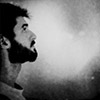 Alvaro Laiz (León, 1981) Master in Visual Arts de Universidad Pontificia de Salamanca. His photographic work focuses on realities that are often forgotten, in areas like Africa, Asia or Southern America. For Laiz, documentary photography is a tool with which he can approach stories that fascinate or worry him, or stories in which he wants to participate from his point of view. With this mindset he co-founded the ONG An-Hua. His work has been published in media like the Sunday Times Magazine, Forbes, British Journal of Photography, National Geographic o New York Times among others.
Alvaro Laiz (León, 1981) Master in Visual Arts de Universidad Pontificia de Salamanca. His photographic work focuses on realities that are often forgotten, in areas like Africa, Asia or Southern America. For Laiz, documentary photography is a tool with which he can approach stories that fascinate or worry him, or stories in which he wants to participate from his point of view. With this mindset he co-founded the ONG An-Hua. His work has been published in media like the Sunday Times Magazine, Forbes, British Journal of Photography, National Geographic o New York Times among others. David Rangel (Torreblanca de los Caños, Sevilla. 1978) Photographer and documentary filmmaker. His professional activity is related to the film industry for over 14 years. Co-founder of An-Hua in order to publicize the forgotten conflicts and document the social, historical and contemporary changes. Focused its commitment issues and concerns related to human rights, anthropology, economics and environment.
David Rangel (Torreblanca de los Caños, Sevilla. 1978) Photographer and documentary filmmaker. His professional activity is related to the film industry for over 14 years. Co-founder of An-Hua in order to publicize the forgotten conflicts and document the social, historical and contemporary changes. Focused its commitment issues and concerns related to human rights, anthropology, economics and environment.
In Uganda, by the beginning of the nineties, corpses kept piling up in the morgues and nobody knew what was going on. During the days when it seemed like hope had escaped that land, a few HIV positive women decided to bring it back, not for them but for their children. That is how NACWOLA (National Community of Women Living with HIV/AIDS) was born, during the International Conference on AIDS held in Amsterdam in 1992. The three founding members died of AIDS during the following years, but their legacy was a ray of light in the darkest days. With the help of European health and psychology professionals, the decided to put in writing what they would never be able to tell their children, and they created the Memory Books. These books are their recollections, they tell us about them and the future they want for their children n pages full of words of care and affection. They are motherhood guides from beyond, survival tutorials for lost children, since over 12% of Sub-Saharan underage population will lose at least one of their parents in the next 12 months, and they will be on their own. As Gladys, the person in charge of the Memory Books project in Luwero, the center of the country, tell us: "They are each special and very personal, in spite of following a common pattern that includes family photos, memories and a family tree. With these books we encourage parents to listen to their children, to talk to them frankly about their disease."
The project is like a big family with members helping each other emotionally and financially in their daily struggle for survival. Mothers, orphans and grandmothers, many of them displaced by the internal war with the LRA (Lord's Resistance Army). In a country where 35% of the population is HIV positive, where there are two million orphans, a country in which polygamy and dowry are common practice, these women are struggling against the AIDS stigma and are not afraid of anything. NACWOLA and the project have given them back hope.






























*ANHUA is a Chinese term that means what the backlight is only seen. His philosophy rests on a fundamental idea: to "Light" the forgotten. Forgotten for any reason: war, displacement, environmental disaters, threats or violations of human rights. We want to help strengthen communication between associations and NGOs from different geographical areas that have no visible spaces to deliver their work and projects. We see in the documentary reports as a tool to approach different interpretations of our environment and help to change unjust realities. We firmly believe that creativity applied to new ways and audiovisual communication is essential in order to promote social change to disadvantaged or minority communities, and also we want to spread world awareness of these situations in the Western. Giving voice to those that no one wants to hear from the direct involvement and through witness always sincere, promoting cultural, educational and social action.
 Alvaro Laiz (León, 1981) Master in Visual Arts de Universidad Pontificia de Salamanca. His photographic work focuses on realities that are often forgotten, in areas like Africa, Asia or Southern America. For Laiz, documentary photography is a tool with which he can approach stories that fascinate or worry him, or stories in which he wants to participate from his point of view. With this mindset he co-founded the ONG An-Hua. His work has been published in media like the Sunday Times Magazine, Forbes, British Journal of Photography, National Geographic o New York Times among others.
Alvaro Laiz (León, 1981) Master in Visual Arts de Universidad Pontificia de Salamanca. His photographic work focuses on realities that are often forgotten, in areas like Africa, Asia or Southern America. For Laiz, documentary photography is a tool with which he can approach stories that fascinate or worry him, or stories in which he wants to participate from his point of view. With this mindset he co-founded the ONG An-Hua. His work has been published in media like the Sunday Times Magazine, Forbes, British Journal of Photography, National Geographic o New York Times among others. David Rangel (Torreblanca de los Caños, Sevilla. 1978) Photographer and documentary filmmaker. His professional activity is related to the film industry for over 14 years. Co-founder of An-Hua in order to publicize the forgotten conflicts and document the social, historical and contemporary changes. Focused its commitment issues and concerns related to human rights, anthropology, economics and environment.
David Rangel (Torreblanca de los Caños, Sevilla. 1978) Photographer and documentary filmmaker. His professional activity is related to the film industry for over 14 years. Co-founder of An-Hua in order to publicize the forgotten conflicts and document the social, historical and contemporary changes. Focused its commitment issues and concerns related to human rights, anthropology, economics and environment.Marta María Pérez

During a lifetime of work, Marta Maria Perez Bravo has explored the rites and beliefs of Cuban religion through her own image. Her body sacrifices the symbol, creating an account of intersections between dualities, such as the visible and the invisible, the material and the spiritual, life after death, the presence of absence. That reiteration of opposites uses its own aesthetic to create narratives that, supported by the photographic document, build a universe of re-creations of rites and ceremonial objects.
Currently, her artistic proposal has led her to use other visual mediums with which she complements and continues to investigate her conceptual interests.














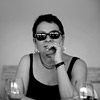 Marta María Pérez Bravo (Cuba, 1959). Lives and works in Mexico. Photographer. She began her studies as an artist in 1979 at the School of Visual Arts San Alejandro, Havana, Cuba. In 1984 she continued her studies at the Instituto Superior de Arte (ISA), Havana, Cuba. She has participated in numerous international solo and group exhibitions. She has won several awards for her work, such as the Guggenheim Fellowship (USA) in 1998.
Marta María Pérez Bravo (Cuba, 1959). Lives and works in Mexico. Photographer. She began her studies as an artist in 1979 at the School of Visual Arts San Alejandro, Havana, Cuba. In 1984 she continued her studies at the Instituto Superior de Arte (ISA), Havana, Cuba. She has participated in numerous international solo and group exhibitions. She has won several awards for her work, such as the Guggenheim Fellowship (USA) in 1998.ZZ. In your work, self-representation is a constant theme, ¿how did your interest in talking about various themes through your own image arise?
MM. I studied Fine Arts, but my graduate thesis, at the Instituto Superior de Arte in Havana (1984), was a photographic project, even though I never studied photography. This project consisted of photographs documenting actions that I performed outdoors, taking as its theme the popular superstitions regarding natural phenomena, appearances etc. When I was pregnant, I could no longer do these performances and I started using my own body. I started to document, in a different way, other actions related to these superstitions and popular beliefs, but now regarding my experience of motherhood. As in the first stage, these realities were constructed and ‘staged’. So, from the beginning, it was clear that using a model or another person, and not my own body would completely change the concept of the work, given that it has a strong autobiographical presence, although implicitly.
ZZ. We see that themes, like evocation and absence, are constant in your work. How have these themes continued to change throughout your career?
MM. In my work, religious themes, especially of afro-cuban origin, started to emerge. The constructed realities (constructed through the staged scenes), that are devoid of time and space, are re-creations (not recreations) of rites and ritual objects.
ZZ. What is the symbolic value of the objects in your photos? What place do you give to the objects as symbols in your photos? What does their reiterative use signify?
From the ritual objects I want to extract a meaning that goes beyond the form, though the making of these objects is done with reference to the originals and the use they are given in religious practices. Although my photography is always black and white, I use the original colors in the elaboration of these objects as a token of respect for these practices and real liturgical objects. Nevertheless, I don’t want the spectator to be distracted by these colors; I want him to focus his attention on the symbols and their meanings. Even though he might not know them at all (since they are object of separate study and profound analysis) my intention is that, when these symbols are interpreted, they evoke ideas and suggest and provoke sensations. In addition to this, the title is a fundamental part of each piece.
ZZ. How does photography help you in the search of your identity? And, what has the use of video added to your work?
Since the beginning of my work in the eighties, my work has been photographic, although five or six years ago it went through a formal change –not its concept nor its aesthetic– through the use of video. The only aspects that make these videos different from my photographic work is the existence of space and the time in which an action occurs. Besides that, my work has not changed; in representing my ideas, I maintain the minimalistic aesthetic, I use the same materials and concepts, I still use black and white and I don’t use audio.
I don’t exactly know in which moment I started using video, but I think it happened in a very natural way, or, in other words, the development of the work itself brought me to it. Actually, people had asked me why I didn’t make videos, because of the performative character of my work, but at the time I, as an artist, was not at all interested in the idea, even though later on I permanently incorporated this medium into my work.
ZZ. What has been the result of your search throughout these years and which course is it taking?
Currently I tend to use video as a medium and not photography, but I still maintain my own aesthetic and conceptual parameters. The only difference is that, at the moment, video is a perfect medium for what I want. Surely the development of my work will lead me to other formal solutions in the future.
I have always thought that maybe a lot of the success of an artist’s work depends on finding the right tool with which he can express and “realize” his ideas.

During a lifetime of work, Marta Maria Perez Bravo has explored the rites and beliefs of Cuban religion through her own image. Her body sacrifices the symbol, creating an account of intersections between dualities, such as the visible and the invisible, the material and the spiritual, life after death, the presence of absence. That reiteration of opposites uses its own aesthetic to create narratives that, supported by the photographic document, build a universe of re-creations of rites and ceremonial objects.
Currently, her artistic proposal has led her to use other visual mediums with which she complements and continues to investigate her conceptual interests.














 Marta María Pérez Bravo (Cuba, 1959). Lives and works in Mexico. Photographer. She began her studies as an artist in 1979 at the School of Visual Arts San Alejandro, Havana, Cuba. In 1984 she continued her studies at the Instituto Superior de Arte (ISA), Havana, Cuba. She has participated in numerous international solo and group exhibitions. She has won several awards for her work, such as the Guggenheim Fellowship (USA) in 1998.
Marta María Pérez Bravo (Cuba, 1959). Lives and works in Mexico. Photographer. She began her studies as an artist in 1979 at the School of Visual Arts San Alejandro, Havana, Cuba. In 1984 she continued her studies at the Instituto Superior de Arte (ISA), Havana, Cuba. She has participated in numerous international solo and group exhibitions. She has won several awards for her work, such as the Guggenheim Fellowship (USA) in 1998.ZZ. In your work, self-representation is a constant theme, ¿how did your interest in talking about various themes through your own image arise?
MM. I studied Fine Arts, but my graduate thesis, at the Instituto Superior de Arte in Havana (1984), was a photographic project, even though I never studied photography. This project consisted of photographs documenting actions that I performed outdoors, taking as its theme the popular superstitions regarding natural phenomena, appearances etc. When I was pregnant, I could no longer do these performances and I started using my own body. I started to document, in a different way, other actions related to these superstitions and popular beliefs, but now regarding my experience of motherhood. As in the first stage, these realities were constructed and ‘staged’. So, from the beginning, it was clear that using a model or another person, and not my own body would completely change the concept of the work, given that it has a strong autobiographical presence, although implicitly.
ZZ. We see that themes, like evocation and absence, are constant in your work. How have these themes continued to change throughout your career?
MM. In my work, religious themes, especially of afro-cuban origin, started to emerge. The constructed realities (constructed through the staged scenes), that are devoid of time and space, are re-creations (not recreations) of rites and ritual objects.
ZZ. What is the symbolic value of the objects in your photos? What place do you give to the objects as symbols in your photos? What does their reiterative use signify?
From the ritual objects I want to extract a meaning that goes beyond the form, though the making of these objects is done with reference to the originals and the use they are given in religious practices. Although my photography is always black and white, I use the original colors in the elaboration of these objects as a token of respect for these practices and real liturgical objects. Nevertheless, I don’t want the spectator to be distracted by these colors; I want him to focus his attention on the symbols and their meanings. Even though he might not know them at all (since they are object of separate study and profound analysis) my intention is that, when these symbols are interpreted, they evoke ideas and suggest and provoke sensations. In addition to this, the title is a fundamental part of each piece.
ZZ. How does photography help you in the search of your identity? And, what has the use of video added to your work?
Since the beginning of my work in the eighties, my work has been photographic, although five or six years ago it went through a formal change –not its concept nor its aesthetic– through the use of video. The only aspects that make these videos different from my photographic work is the existence of space and the time in which an action occurs. Besides that, my work has not changed; in representing my ideas, I maintain the minimalistic aesthetic, I use the same materials and concepts, I still use black and white and I don’t use audio.
I don’t exactly know in which moment I started using video, but I think it happened in a very natural way, or, in other words, the development of the work itself brought me to it. Actually, people had asked me why I didn’t make videos, because of the performative character of my work, but at the time I, as an artist, was not at all interested in the idea, even though later on I permanently incorporated this medium into my work.
ZZ. What has been the result of your search throughout these years and which course is it taking?
Currently I tend to use video as a medium and not photography, but I still maintain my own aesthetic and conceptual parameters. The only difference is that, at the moment, video is a perfect medium for what I want. Surely the development of my work will lead me to other formal solutions in the future.
I have always thought that maybe a lot of the success of an artist’s work depends on finding the right tool with which he can express and “realize” his ideas.
Jan Rosseel

In the autumn of 1985, a series of violent and bloody robberies of Belgian supermarkets abruptly came to an end. A group of unknown criminals, referred to as ´The Gang of Nivelles´, was held responsible for these heinous acts. Between March 1982 and November 1985, the Gang of Nivelles committed twenty-three robberies and other crimes.
In all, twenty-eight people were killed.
My father was one of them.
The excessive violence used by the gang, was out of all proportion to the modest loot of 175,000 euros. In spite of a thorough police investigation, a file of almost three million pages, found evidence and witness accounts, the perpetrators were never apprehended. This period of terror and violence will remain one of the darkest pages in Belgian history.
















 Jan Rosseel (Brussels, 1979). Studied Documentary Photography at the Royal Academy of Arts in The Hague, The Netherlands and Photojournalism at the Danish School of Media and Journalism in Aarhus, Denmark. His work is best described as visual storytelling. He works as a collector of memories using photography, video and objects. The starting point of his research-based projects are historical events and the notion of memory. To see more of his work go to: janrosseel.com
Jan Rosseel (Brussels, 1979). Studied Documentary Photography at the Royal Academy of Arts in The Hague, The Netherlands and Photojournalism at the Danish School of Media and Journalism in Aarhus, Denmark. His work is best described as visual storytelling. He works as a collector of memories using photography, video and objects. The starting point of his research-based projects are historical events and the notion of memory. To see more of his work go to: janrosseel.com
In the autumn of 1985, a series of violent and bloody robberies of Belgian supermarkets abruptly came to an end. A group of unknown criminals, referred to as ´The Gang of Nivelles´, was held responsible for these heinous acts. Between March 1982 and November 1985, the Gang of Nivelles committed twenty-three robberies and other crimes.
In all, twenty-eight people were killed.
My father was one of them.
The excessive violence used by the gang, was out of all proportion to the modest loot of 175,000 euros. In spite of a thorough police investigation, a file of almost three million pages, found evidence and witness accounts, the perpetrators were never apprehended. This period of terror and violence will remain one of the darkest pages in Belgian history.
















 Jan Rosseel (Brussels, 1979). Studied Documentary Photography at the Royal Academy of Arts in The Hague, The Netherlands and Photojournalism at the Danish School of Media and Journalism in Aarhus, Denmark. His work is best described as visual storytelling. He works as a collector of memories using photography, video and objects. The starting point of his research-based projects are historical events and the notion of memory. To see more of his work go to: janrosseel.com
Jan Rosseel (Brussels, 1979). Studied Documentary Photography at the Royal Academy of Arts in The Hague, The Netherlands and Photojournalism at the Danish School of Media and Journalism in Aarhus, Denmark. His work is best described as visual storytelling. He works as a collector of memories using photography, video and objects. The starting point of his research-based projects are historical events and the notion of memory. To see more of his work go to: janrosseel.comAntonio Contreras & Rafael Torrado
We stopped for a smoke under a bridge and saw three characters seated on a couch in front of a large stone screen. We told them we were photographers and wanted to take their picture. In the beginning they were shy (we were too) and we began by taking pictures of the place: the living room, the bathroom, the house, the garden. We gradually got to know each other better. They liked our idea and we visited them a couple more times. One day, everything was gone; neither a trace of them nor their belongings remained. We decided to investigate what had happened on the other side of the bridge, where people had also settled.
That is where we met Manuelín, the owner of a small house located between the light rail tracks of Mexico City and an overpass. We asked him about our vanished acquaintances, and he said that a there had been a police operation and a number of people had been arrested. We never found out anything else; no one knew their names. Manuelín and his friends welcomed us from the start and that same day they took us to "The Den", a place where the floor is made up of an immense mass of clothing and garbage, where rats and cockroaches turn up at every step. It was a place that was abandoned by the group after being flooded with rain water.
This is how The Best of the Worst was born, initially a photographic and then a video project that is midway between documentary and fiction, anthropology and journalism.
The photographs that comprise the first portion of this work result from the spontaneity and imagination of Manuelín and company, as well as from a constant effort to capture various moments of these characters in their own space: a peaceful afternoon “chilling” on the bridge, a hot day spent drinking amidst trucks and trains, a nighttime party and the next morning’s hangover.
This is their story.
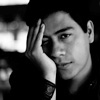 Antonio Contreras (Mexico). Lives and works in Mexico City. He studied social communication at the Universidad Autónoma Metropolitana. In 2014 he participated in the diploma course Photo Narrative and New Media from the Pedro Meyer Foundation. He regularly publishes in the collective blog Parteuno
Antonio Contreras (Mexico). Lives and works in Mexico City. He studied social communication at the Universidad Autónoma Metropolitana. In 2014 he participated in the diploma course Photo Narrative and New Media from the Pedro Meyer Foundation. He regularly publishes in the collective blog Parteuno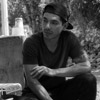 Rafael Torrado (Mexico). Mexican photographer born in Mexico City. Bachelor student in Social Communication at the Universidad Autónoma Metropolitana. Since 2011 he has worked in the field of documentary photography, where he develops the subjects of violence, drugs, discrimination and social movements.
Rafael Torrado (Mexico). Mexican photographer born in Mexico City. Bachelor student in Social Communication at the Universidad Autónoma Metropolitana. Since 2011 he has worked in the field of documentary photography, where he develops the subjects of violence, drugs, discrimination and social movements.
We stopped for a smoke under a bridge and saw three characters seated on a couch in front of a large stone screen. We told them we were photographers and wanted to take their picture. In the beginning they were shy (we were too) and we began by taking pictures of the place: the living room, the bathroom, the house, the garden. We gradually got to know each other better. They liked our idea and we visited them a couple more times. One day, everything was gone; neither a trace of them nor their belongings remained. We decided to investigate what had happened on the other side of the bridge, where people had also settled.
That is where we met Manuelín, the owner of a small house located between the light rail tracks of Mexico City and an overpass. We asked him about our vanished acquaintances, and he said that a there had been a police operation and a number of people had been arrested. We never found out anything else; no one knew their names. Manuelín and his friends welcomed us from the start and that same day they took us to "The Den", a place where the floor is made up of an immense mass of clothing and garbage, where rats and cockroaches turn up at every step. It was a place that was abandoned by the group after being flooded with rain water.
This is how The Best of the Worst was born, initially a photographic and then a video project that is midway between documentary and fiction, anthropology and journalism.
The photographs that comprise the first portion of this work result from the spontaneity and imagination of Manuelín and company, as well as from a constant effort to capture various moments of these characters in their own space: a peaceful afternoon “chilling” on the bridge, a hot day spent drinking amidst trucks and trains, a nighttime party and the next morning’s hangover.
This is their story.
 Antonio Contreras (Mexico). Lives and works in Mexico City. He studied social communication at the Universidad Autónoma Metropolitana. In 2014 he participated in the diploma course Photo Narrative and New Media from the Pedro Meyer Foundation. He regularly publishes in the collective blog Parteuno
Antonio Contreras (Mexico). Lives and works in Mexico City. He studied social communication at the Universidad Autónoma Metropolitana. In 2014 he participated in the diploma course Photo Narrative and New Media from the Pedro Meyer Foundation. He regularly publishes in the collective blog Parteuno Rafael Torrado (Mexico). Mexican photographer born in Mexico City. Bachelor student in Social Communication at the Universidad Autónoma Metropolitana. Since 2011 he has worked in the field of documentary photography, where he develops the subjects of violence, drugs, discrimination and social movements.
Rafael Torrado (Mexico). Mexican photographer born in Mexico City. Bachelor student in Social Communication at the Universidad Autónoma Metropolitana. Since 2011 he has worked in the field of documentary photography, where he develops the subjects of violence, drugs, discrimination and social movements.Rania Matar

A girl and her room
A Girl and Her Room was inspired by my oldest daughter, then 15, who was no longer a carefree child. She was shifting into adulthood incrementally before my eyes. After photographing her with her girlfriends, I realized I wanted to capture each young woman by herself in her own environment: her bedroom. The room was a metaphor, an extension of the girl, but also the girl seemed to be part of the room, to fit in just like everything else in the material and emotional space she created.
While I initially focused on teenage girls in the United States, I eventually expanded the project to include girls from the other world I experienced myself as a young woman: the Middle East. This is how this project became personal to me. The beauty, dreams, vulnerability and strength of these young women, regardless of place, background and religion, were beautifully universal and deeply moving.
Being with those young women in the privacy of their world gave me a unique peek into their private lives and their inner selves. They sensed that I was not judging them and became an active part of the project. Their frankness and generosity in sharing access was a privilege that they have extended to me but also to all the viewers of this work.

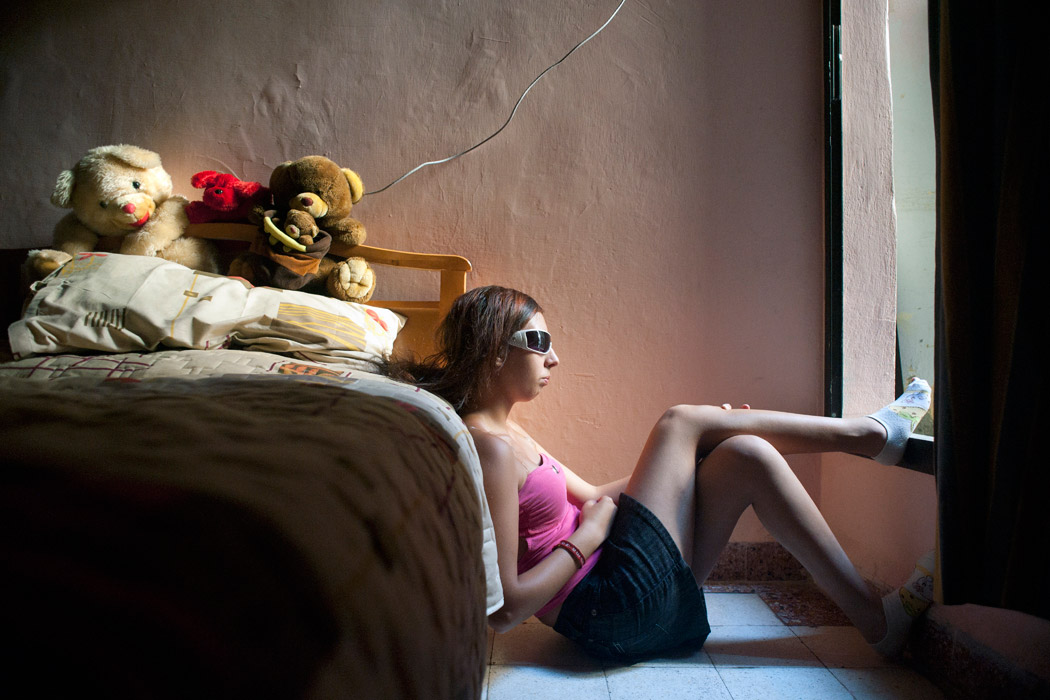




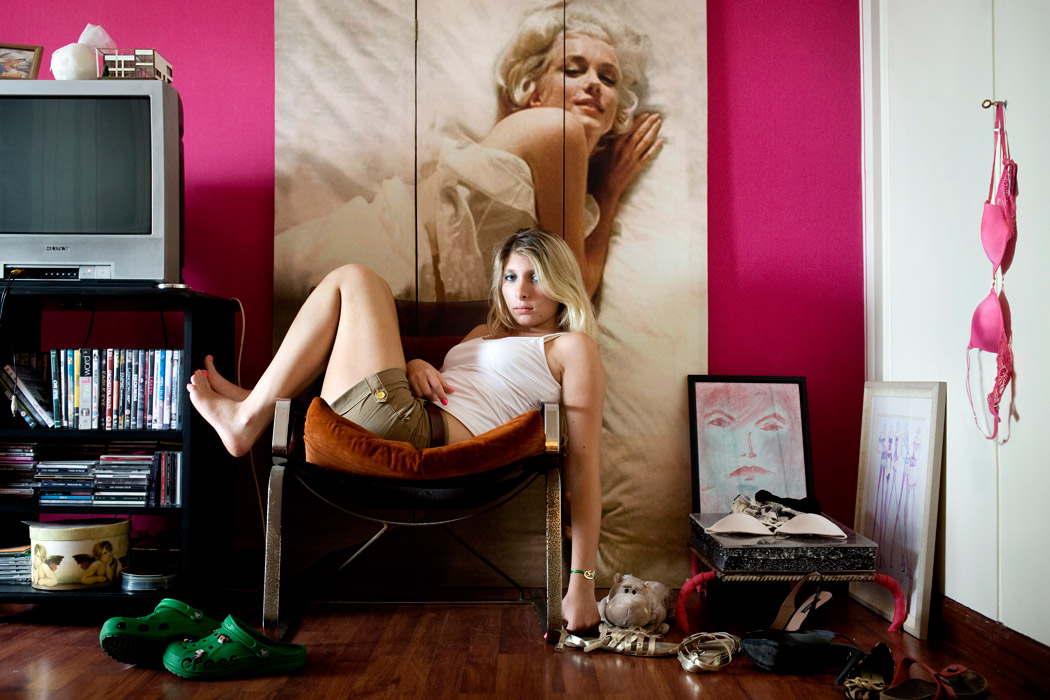




























 Rania Matar (Lebanon, 1964). Originally trained as an architect at the American University of Beirut and at Cornell University, she studied photography at the New England School of Photography and the Maine Photographic Workshops. Her work focuses on girls and women. She documents her life through the lives of those around her, focusing on the personal and the mundane in an attempt to portray the universal within the personal. Her work has won several awards, is part of several museum and private collections, has been featured in numerous publications, and exhibited widely in the U.S. and internationally. Visit her website: raniamatar.com
Rania Matar (Lebanon, 1964). Originally trained as an architect at the American University of Beirut and at Cornell University, she studied photography at the New England School of Photography and the Maine Photographic Workshops. Her work focuses on girls and women. She documents her life through the lives of those around her, focusing on the personal and the mundane in an attempt to portray the universal within the personal. Her work has won several awards, is part of several museum and private collections, has been featured in numerous publications, and exhibited widely in the U.S. and internationally. Visit her website: raniamatar.com
A girl and her room
A Girl and Her Room was inspired by my oldest daughter, then 15, who was no longer a carefree child. She was shifting into adulthood incrementally before my eyes. After photographing her with her girlfriends, I realized I wanted to capture each young woman by herself in her own environment: her bedroom. The room was a metaphor, an extension of the girl, but also the girl seemed to be part of the room, to fit in just like everything else in the material and emotional space she created.
While I initially focused on teenage girls in the United States, I eventually expanded the project to include girls from the other world I experienced myself as a young woman: the Middle East. This is how this project became personal to me. The beauty, dreams, vulnerability and strength of these young women, regardless of place, background and religion, were beautifully universal and deeply moving.
Being with those young women in the privacy of their world gave me a unique peek into their private lives and their inner selves. They sensed that I was not judging them and became an active part of the project. Their frankness and generosity in sharing access was a privilege that they have extended to me but also to all the viewers of this work.



































 Rania Matar (Lebanon, 1964). Originally trained as an architect at the American University of Beirut and at Cornell University, she studied photography at the New England School of Photography and the Maine Photographic Workshops. Her work focuses on girls and women. She documents her life through the lives of those around her, focusing on the personal and the mundane in an attempt to portray the universal within the personal. Her work has won several awards, is part of several museum and private collections, has been featured in numerous publications, and exhibited widely in the U.S. and internationally. Visit her website: raniamatar.com
Rania Matar (Lebanon, 1964). Originally trained as an architect at the American University of Beirut and at Cornell University, she studied photography at the New England School of Photography and the Maine Photographic Workshops. Her work focuses on girls and women. She documents her life through the lives of those around her, focusing on the personal and the mundane in an attempt to portray the universal within the personal. Her work has won several awards, is part of several museum and private collections, has been featured in numerous publications, and exhibited widely in the U.S. and internationally. Visit her website: raniamatar.comKarolina Jonderko

I remember the joy of discovering Haribo jellies, Nutella and margarine among colorful clothes packed in heavy cardboard boxes we used to get from relatives who lived in West Germany, when Poland was lacking many basic things. It was a celebration, the whole family was present for these grand openings of gift boxes.
The clothes, mostly second-hand, were good enough for mother. She never felt the need to buy new ones, preferring to save money for more important expenses. She always looked modest and didn’t like black. Some say that what one wears is (a) part of creating one’s identity. My mother, all her life, wore clothes that she had never chosen.
On February 28, 2012, four years after her death, I started reliving the past. My work since then has been about building on my memories and longing. Self-Portrait With My Mother is an attempt to summarize that period, to move beyond the past -a final reconciliation with reality.
My grandmother’s house –where my mother, my sister and me (all) grew up– is empty and cold now, almost in ruins. This is where I’ve kept my mother’s clothes since she died. And now after my grandmother passed away, it’s where I’ve been making these self-portraits, recreating dresses and outfits from memory, like my mother used to match them. I recently tried on a different set of clothes that came in one of those big boxes many years ago. I found her blond hair on the green coat.

Home clothes. I remember her sitting at the piano, focused, her hand tapping the rhythm, patiently listening to the rattle of her students, and I can still hear her gentle voice: let’s repeat this fragment. How was she able to listen to that; I do not know till this day. My sister and I would leave the house after a few minutes.

Wedding clothes. I am 7 years old, the early nineties, cousin’s wedding, 150 guests; Most of them I don’t know. I am stuffing my mouth with a cake while watching my parents dancing to a bad version of Krawczyk’s song. My mother loved to dance and she was good at it. They looked great together, understanding without words. She did not like this type of feasts. Chatting with relatives, whom you see only at weddings and funerals. What to talk to them about? It’s much better to dance and send smiles.

Work clothes. Small, badly furnished office in No 2 Primary School, that both I and my sister attended. On the door “The Principal of After School Activities”. Mum at her desk, writing a report regarding achievements of "Alkatras"(a club for youngsters with problems) and “Orlik” (club for children and teenagers) for a meeting (meeting) with the town mayor. I'm waiting patiently in the corner; I want to walk home with her.

For the journey clothes. The departure day. Crowd on the platform. I am clasping my mum's and sister's hands. Suddenly I am rising. It's my mum passing me to my dad through the compartment's window. I am followed by two suitcases. My mum and sister somehow join us. It's crowded and stuffy and it will be like that for the next 14 hours. However, a 2 week seaside holiday is worth it. Mum has prepared sandwiches, hard-boiled eggs, tomatoes and tea in a 'Wyborowa' vodka bottle. We have 'Happy Minutes' ( a children's puzzle magazine in communist Poland). She loves the sea. She travels lost in her thoughts. I think she can already smell the sea and hear the waves and screeching seagulls. Her blue dress may be made from cheap material, but it doesn't crease and dries in 2 minutes - perfect for such journeys.

Christmas clothes. It’s Christmas Eve. Mom is busy in the kitchen, taking golden carp out of the oven carefully, to not stain herself with the hot butter. She is even wearing makeup, green, to match the outfit. She’s happy. She loves Christmas. After dinner, she is sitting at the piano and we all are singing Christmas carols.

Weekend clothes. Sunny day. The whole family sits in my grandmother’s garden, sausages on the grill, twittering birds, laughter, conversation. In this dress, my mother always smiled, relaxed. She wore it only on sunny days, free from work.

Kindergarten clothes. At the coal mine's kindergarten she would prepare the little ones for many performances. She would teach them songs about beloved mothers, the blackened faces of miners or brave marching Polish soldiers. She knew a song for every occasion. She wore blouses with big geometric patterns for the children. They loved her, the happy plump lady who, with rosy cheeks, accompanied their singing on the piano in front of their proud parents.

Sunday best clothes. It's Saint George's day. The whole family goes to the church fair. First we check out stands full of plastic toys, then the shooting range where dad manages to win mum a bunch of garish, fake flowers. Pink candy floss can't be missed. My sister and I have to stamp our feet to get it, as it's not healthy and bad for our teeth. But mum always gives in and on top of this grandma gives us two 'golden' rings with pink 'gems'. Total bliss. After the merry-go-round, we plead for one more go, just one more. And then we're going back, bangers going off in the background, mum, dad and grandma are happy, chatty; my sister is playing a toy whistle; and me with a mandatory baloon tied to my wrist.

Winter clothes. She would leave for work in darkness; we would all be still asleep. She would take a red bus to her work at the music school. We didn’t have a car. Waiting for the bus, bitter cold, the uncertainty whether it would come or not, shifting from foot to foot. On the way back she would do the shoppings. She would move slowly with the heavy bags, being careful not to slip. Freezing cold, with a red nose and cheeks, she would enter the house. Every night her soaked black boots would stand in a puddle of melted snow under a radiator in the kitchen.

Holiday clothes. It's summer. Apart from the intensively bright sun and the smell of freshly brewed coffee, mum's voice wakes us up. I have a quick peek through the curtains, the wash must have been hung outside early in the morning, it looks completely dry. I cannot see anyone, but I know she's there. I crane my neck and I am just able to make out blonde locks and cigarette smoke. The morning 'gossip' with the neighbours is in full swing. Bare-footed and in pyjamas my sister and I jump (out) on the balcony and join the discussion. We love summer. For two months we have our mum to ourselves, because of the summer holiday.
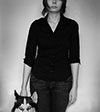 Karolina Jonderko (Poland, 1985). Lives and works in Poland. She graduated at the Silesian Voivedship Marshall in the field of culture and at Warsaw Film School. Currently Karolina is a student of photography at the Polish National Film, Television and Theatre School in Lodz. She has participated in various national and international exhibitions. Her works are based mostly on experiences and childhood memories. To see more of her work go to: karolinajonderko
Karolina Jonderko (Poland, 1985). Lives and works in Poland. She graduated at the Silesian Voivedship Marshall in the field of culture and at Warsaw Film School. Currently Karolina is a student of photography at the Polish National Film, Television and Theatre School in Lodz. She has participated in various national and international exhibitions. Her works are based mostly on experiences and childhood memories. To see more of her work go to: karolinajonderko[core_state] => 1 [core_access] => 1 [core_metadata] => {"robots":"","author":"Karolina Jonderko","rights":"","xreference":""} [core_created_user_id] => 838 [core_created_by_alias] => [core_created_time] => 2014-10-21 21:14:03 [core_images] => {"image_intro":"images\/categories\/liquididentity\/jordeko.jpg","float_intro":"","image_intro_alt":"","image_intro_caption":"","image_fulltext":"images\/categories\/liquididentity\/jordeko.jpg","float_fulltext":"","image_fulltext_alt":"","image_fulltext_caption":""} [core_modified_time] => 2015-09-30 17:48:39 [core_language] => en-GB [core_catid] => 47 [core_publish_up] => 2014-10-21 21:13:16 [core_publish_down] => 0000-00-00 00:00:00 [content_type_title] => Article [router] => ContentHelperRoute::getArticleRoute [author] => Elisa Rugo [author_email] => elisa@zonezero.com [link] => index.php?option=com_content&view=article&id=210:self-portrait-with-my-mother&catid=47&lang=en-GB [displayDate] => 2014-10-21 21:13:16 [event] => stdClass Object ( [afterDisplayTitle] => [beforeDisplayContent] => [afterDisplayContent] => ) [text] =>

I remember the joy of discovering Haribo jellies, Nutella and margarine among colorful clothes packed in heavy cardboard boxes we used to get from relatives who lived in West Germany, when Poland was lacking many basic things. It was a celebration, the whole family was present for these grand openings of gift boxes.
The clothes, mostly second-hand, were good enough for mother. She never felt the need to buy new ones, preferring to save money for more important expenses. She always looked modest and didn’t like black. Some say that what one wears is (a) part of creating one’s identity. My mother, all her life, wore clothes that she had never chosen.
On February 28, 2012, four years after her death, I started reliving the past. My work since then has been about building on my memories and longing. Self-Portrait With My Mother is an attempt to summarize that period, to move beyond the past -a final reconciliation with reality.
My grandmother’s house –where my mother, my sister and me (all) grew up– is empty and cold now, almost in ruins. This is where I’ve kept my mother’s clothes since she died. And now after my grandmother passed away, it’s where I’ve been making these self-portraits, recreating dresses and outfits from memory, like my mother used to match them. I recently tried on a different set of clothes that came in one of those big boxes many years ago. I found her blond hair on the green coat.

Home clothes. I remember her sitting at the piano, focused, her hand tapping the rhythm, patiently listening to the rattle of her students, and I can still hear her gentle voice: let’s repeat this fragment. How was she able to listen to that; I do not know till this day. My sister and I would leave the house after a few minutes.

Wedding clothes. I am 7 years old, the early nineties, cousin’s wedding, 150 guests; Most of them I don’t know. I am stuffing my mouth with a cake while watching my parents dancing to a bad version of Krawczyk’s song. My mother loved to dance and she was good at it. They looked great together, understanding without words. She did not like this type of feasts. Chatting with relatives, whom you see only at weddings and funerals. What to talk to them about? It’s much better to dance and send smiles.

Work clothes. Small, badly furnished office in No 2 Primary School, that both I and my sister attended. On the door “The Principal of After School Activities”. Mum at her desk, writing a report regarding achievements of "Alkatras"(a club for youngsters with problems) and “Orlik” (club for children and teenagers) for a meeting (meeting) with the town mayor. I'm waiting patiently in the corner; I want to walk home with her.

For the journey clothes. The departure day. Crowd on the platform. I am clasping my mum's and sister's hands. Suddenly I am rising. It's my mum passing me to my dad through the compartment's window. I am followed by two suitcases. My mum and sister somehow join us. It's crowded and stuffy and it will be like that for the next 14 hours. However, a 2 week seaside holiday is worth it. Mum has prepared sandwiches, hard-boiled eggs, tomatoes and tea in a 'Wyborowa' vodka bottle. We have 'Happy Minutes' ( a children's puzzle magazine in communist Poland). She loves the sea. She travels lost in her thoughts. I think she can already smell the sea and hear the waves and screeching seagulls. Her blue dress may be made from cheap material, but it doesn't crease and dries in 2 minutes - perfect for such journeys.

Christmas clothes. It’s Christmas Eve. Mom is busy in the kitchen, taking golden carp out of the oven carefully, to not stain herself with the hot butter. She is even wearing makeup, green, to match the outfit. She’s happy. She loves Christmas. After dinner, she is sitting at the piano and we all are singing Christmas carols.

Weekend clothes. Sunny day. The whole family sits in my grandmother’s garden, sausages on the grill, twittering birds, laughter, conversation. In this dress, my mother always smiled, relaxed. She wore it only on sunny days, free from work.

Kindergarten clothes. At the coal mine's kindergarten she would prepare the little ones for many performances. She would teach them songs about beloved mothers, the blackened faces of miners or brave marching Polish soldiers. She knew a song for every occasion. She wore blouses with big geometric patterns for the children. They loved her, the happy plump lady who, with rosy cheeks, accompanied their singing on the piano in front of their proud parents.

Sunday best clothes. It's Saint George's day. The whole family goes to the church fair. First we check out stands full of plastic toys, then the shooting range where dad manages to win mum a bunch of garish, fake flowers. Pink candy floss can't be missed. My sister and I have to stamp our feet to get it, as it's not healthy and bad for our teeth. But mum always gives in and on top of this grandma gives us two 'golden' rings with pink 'gems'. Total bliss. After the merry-go-round, we plead for one more go, just one more. And then we're going back, bangers going off in the background, mum, dad and grandma are happy, chatty; my sister is playing a toy whistle; and me with a mandatory baloon tied to my wrist.

Winter clothes. She would leave for work in darkness; we would all be still asleep. She would take a red bus to her work at the music school. We didn’t have a car. Waiting for the bus, bitter cold, the uncertainty whether it would come or not, shifting from foot to foot. On the way back she would do the shoppings. She would move slowly with the heavy bags, being careful not to slip. Freezing cold, with a red nose and cheeks, she would enter the house. Every night her soaked black boots would stand in a puddle of melted snow under a radiator in the kitchen.

Holiday clothes. It's summer. Apart from the intensively bright sun and the smell of freshly brewed coffee, mum's voice wakes us up. I have a quick peek through the curtains, the wash must have been hung outside early in the morning, it looks completely dry. I cannot see anyone, but I know she's there. I crane my neck and I am just able to make out blonde locks and cigarette smoke. The morning 'gossip' with the neighbours is in full swing. Bare-footed and in pyjamas my sister and I jump (out) on the balcony and join the discussion. We love summer. For two months we have our mum to ourselves, because of the summer holiday.
 Karolina Jonderko (Poland, 1985). Lives and works in Poland. She graduated at the Silesian Voivedship Marshall in the field of culture and at Warsaw Film School. Currently Karolina is a student of photography at the Polish National Film, Television and Theatre School in Lodz. She has participated in various national and international exhibitions. Her works are based mostly on experiences and childhood memories. To see more of her work go to: karolinajonderko
Karolina Jonderko (Poland, 1985). Lives and works in Poland. She graduated at the Silesian Voivedship Marshall in the field of culture and at Warsaw Film School. Currently Karolina is a student of photography at the Polish National Film, Television and Theatre School in Lodz. She has participated in various national and international exhibitions. Her works are based mostly on experiences and childhood memories. To see more of her work go to: karolinajonderko[id] => 210 [language] => en-GB [catid] => 47 [jcfields] => Array ( ) ) 1
Bahbak Hashemi-Nezhad

These images are the results of chance public encounters during a series of walks in Bolderaja, a largely Russian-speaking area of Riga which was industrialised and militarised during the soviet occupation.
Over three days in late November 2013, members of the public were requested to remotely photograph themselves and momentarily act out their everyday realities whilst continuing the situations in which they were encountered.
Set against new and yet to be completed housing developments, industrial estates, local businesses and suburban landscapes, these self-portraits act as vignettes, highlighting the roles the individuals play and the pleasures they experience in the public realm.


















The Riga Self-portraits were made in the context of the international community art project 'Contemporary Self-Portraits'. During this two-year project (September 2012–August 2014), self-portrait workshops were held in various European regions: Finland (Turku), Estonia (Tallinn), Ireland (Dublin), Latvia (Riga) and Sweden (Umeå).
The aim was to give local inhabitants a voice in expressing their personal and collective identity, as well as to encourage the development and sharing of communal art methodology and community development through arts.
The results were presented at exhibitions in each partner country and at a Final Symposium in Umea in 2014.
 Bahbak Hashemi-Nezhad (England, 1979). He graduated from the Royal College of Art in 2008 and founded a cross-disciplinary practice that has produced work ranging from product design, domestic and public spaces, photography, to food, games and public interventions. His practice is concerned with exploring the role of photography within design research, and with developing new design methodologies that actively engage individual users. bh-n.com
Bahbak Hashemi-Nezhad (England, 1979). He graduated from the Royal College of Art in 2008 and founded a cross-disciplinary practice that has produced work ranging from product design, domestic and public spaces, photography, to food, games and public interventions. His practice is concerned with exploring the role of photography within design research, and with developing new design methodologies that actively engage individual users. bh-n.com
These images are the results of chance public encounters during a series of walks in Bolderaja, a largely Russian-speaking area of Riga which was industrialised and militarised during the soviet occupation.
Over three days in late November 2013, members of the public were requested to remotely photograph themselves and momentarily act out their everyday realities whilst continuing the situations in which they were encountered.
Set against new and yet to be completed housing developments, industrial estates, local businesses and suburban landscapes, these self-portraits act as vignettes, highlighting the roles the individuals play and the pleasures they experience in the public realm.


















The Riga Self-portraits were made in the context of the international community art project 'Contemporary Self-Portraits'. During this two-year project (September 2012–August 2014), self-portrait workshops were held in various European regions: Finland (Turku), Estonia (Tallinn), Ireland (Dublin), Latvia (Riga) and Sweden (Umeå).
The aim was to give local inhabitants a voice in expressing their personal and collective identity, as well as to encourage the development and sharing of communal art methodology and community development through arts.
The results were presented at exhibitions in each partner country and at a Final Symposium in Umea in 2014.
 Bahbak Hashemi-Nezhad (England, 1979). He graduated from the Royal College of Art in 2008 and founded a cross-disciplinary practice that has produced work ranging from product design, domestic and public spaces, photography, to food, games and public interventions. His practice is concerned with exploring the role of photography within design research, and with developing new design methodologies that actively engage individual users. bh-n.com
Bahbak Hashemi-Nezhad (England, 1979). He graduated from the Royal College of Art in 2008 and founded a cross-disciplinary practice that has produced work ranging from product design, domestic and public spaces, photography, to food, games and public interventions. His practice is concerned with exploring the role of photography within design research, and with developing new design methodologies that actively engage individual users. bh-n.comPage 2 of 3
Page 2 of 3

